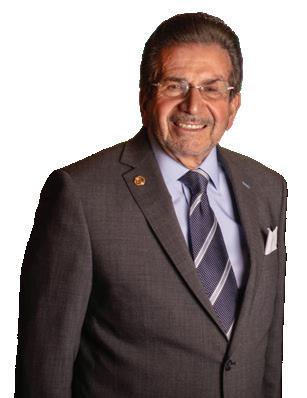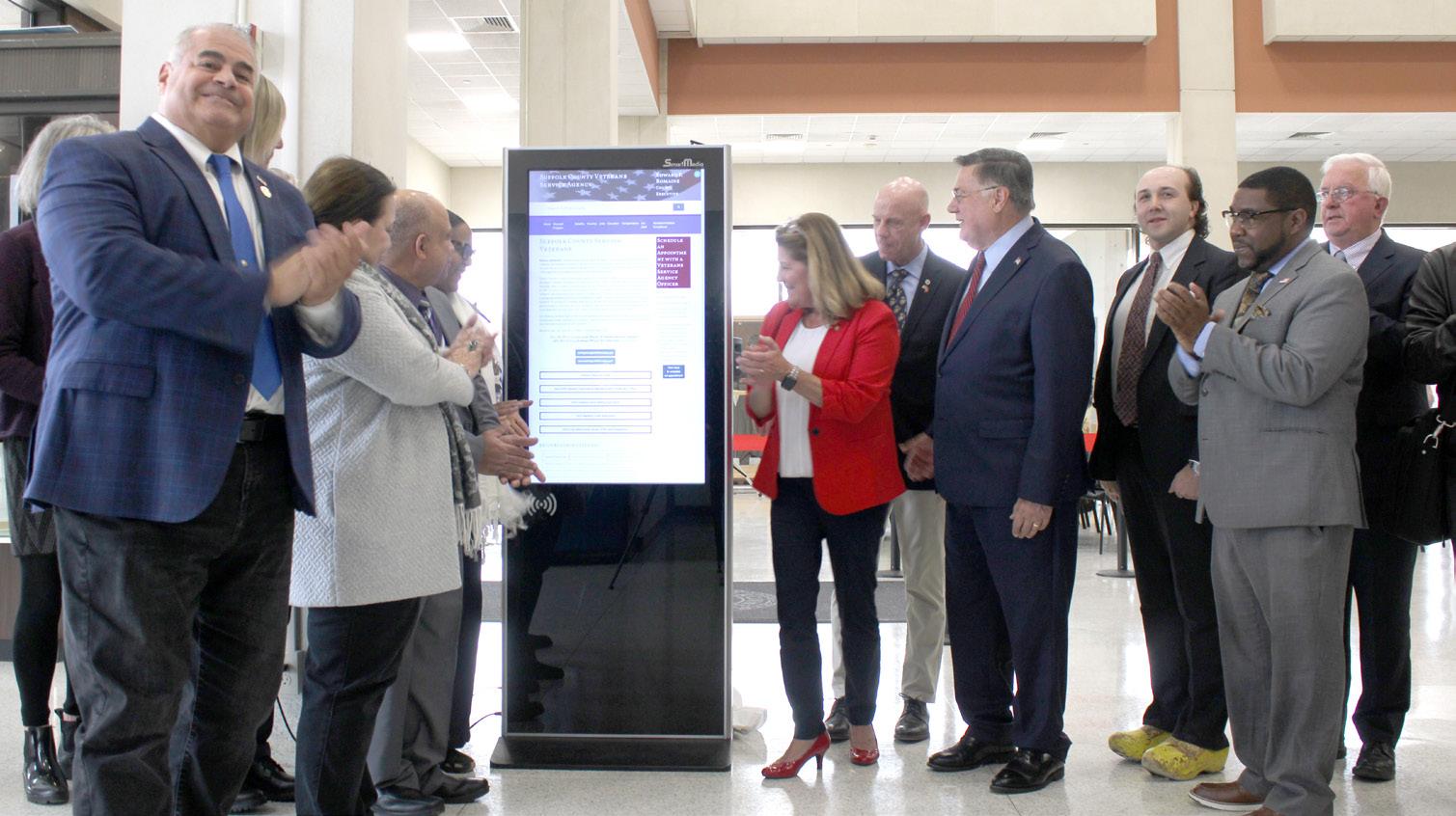

Elise Stefanik Jumps in 2026 Gubernatorial Race
By Matt Meduri
By Matt Meduri
After months of speculation, Congresswoman Elise Stefanik (R, NY-21) has formally declared her candidacy for Governor of New York in the 2026 midterm elections.
The Schuylerville Republican began posturing for the seat in April. She was originally teed up to become President Donald Trump’s (R-FL) Ambassador to the United Nations. While her nomination was not nearly as controversial as some of his other selections, Stefanik was withdrawn from the process.
Continued on page 4 U.S. Congresswoman





Residents Speak on Closure of Holtsville Ecology Site
By Matt Meduri
At the November 6 evening board meeting to discuss the Town’s FY2026 budget, many public comments were dedicated to the beloved Holtsville Ecology Site, founded in 1979 by then-Brookhaven Superintendent of Highways Harold H. Malkmes - for whom the site is formally named. Malkmes was known as a florist who was urged into politics. He served as the Town’s Highway Superintendent from the 1970s until 2000. The site was constructed at the Town’s compost facility, and the ecology aspect came in when the Highway workers tended to barnyard animals to entertain children while their parents received their compost.
Continued on page 10



Elise Stefanik speaking at the 2025 Conservative Political Action Conference (CPAC) at the Gaylord National Resort & Convention Center in National Harbor, Maryland. (Credit - Gage Skidmore)
The entrance arch to the Holtsville Ecology Site (Credit - Matt Meduri)
FALL EVENTS
Port Jefferson Summer Farmers Market at Harborfront Park
Every Saturday and Sunday, May 18-November 28 9:00 AM to 2:00 PM
Islip Farmers Market at Town Hall
Every Saturday June 7 - November 22 7:00 AM to 12:00 PM
Second Annual Turkey Drive at Station Yards
November 14, 7:30 AM to 6:00 PM
Stony Brook Artisans Showcase Art and Craft Fair
November 15-16, 10:00 AM to 4:00 PM
St. John’s Holiday Craft Fair
November 15,


Fest at the Farm at Suffolk County Farm & Education Center, Yaphank
November 15, 11:00 AM to 5:00 PM
East Islip Craft Fair
November 22-23, 10:00 AM to 4:00 PM
“Friendsgiving”
Tribute to the 80s Dance Party
November 22, 6:00 PM to 11:00 PM
Thanksgiving Dinner at East Wind
November 27, 1:00 PM to 6:00 PM
Miracle on Main Street in Sayville
November 29, 5:00 PM to 9:00 PM
Port Jefferson Santa Parade & Visit
November 30, 3:00 PM to 5:00 PM
Port Jefferson Festival of Trees
December 1-January 2, 8:00 AM to 8:00 PM
Christmas Tree Painting Night at Plasterkraze 2
December 3, 6:15 PM to 8:30 PM

Spanning Four Generations
Conveniently Located,
Conveniently
Conveniently
PUBLISHER
Raheem Soto
EDITOR-IN-CHIEF
Meduri
Sergio A. Fabbri
PJ Balzer
Ashley Pavlakis
Madison Warren
OFFICE
Kim Revere
PROOFREADER
Giavanna Rudilosso
SOCIAL
Madison Warren

























WHERE TO FIND OUR PAPER
BELLPORT
Cafe Castello • South Country Deli
BROOKHAVEN
Anthony’s Pizza
CENTEREACH
Centereach Deli • Fratelli’s Pork Store JeJoJos Bagels Inc.
CENTER MORICHES King Kullen
CORAM La Bistro
EASTPORT
Pete’s Bagels • King Kullen
EAST SETAUKET
Bagel Express • CVS
Pumpernickels Delicatessen & Market
Rolling Pin Bakery • Se-port Deli • Starbucks
RONKONKOMA
718 Slice Pizzeria – (719 Hawkins Ave)
Ronkonkoma Train Station
LAKE GROVE
Buffin Muffin / Hummus Fit
Lake Grove Diner • Lake Grove Village Hall
MILLER PLACE
Better on a Bagel • Bigger Bagel and Deli
Crazy Beans • CVS • Miller Place Bagel & Deli
Papa Juan’s • Playa Bowls • Starbucks Town & Country Market
MT. SINAI
Bagels Your Way • Heritage Diner Northside Deli
PATCHOGUE
California Diner • King Kullen • Shop Rite
Sugar Dream Bakery • Swan Bakery
PORT JEFFERSON
CVS • Southdown Coffee • Starbucks
PORT JEFFERSON STATION
Bagel Deli Gourmet • IHOP
Toast Coffe House • Wunderbar Deli
ROCKY POINT
Fresh & Hot Bagels
Rocky Point Cardsmart (Kohl’s Plaza)
SELDEN
Cella Bagels • Joe’s Campus Heroes
SHIRLEY
Bagel Deli • Freshy Bagels
Laundry King • Stop & Shop
STONY BROOK
Long Island Bagel Cafe • Strathmore Bagels
Library News
Thursday, November 13, 2025
NORTH SHORE:
Ask a Genealogist! - November 16, 11:00 AM
LONGWOOD:
Happy Birthday, Mickey Mouse - Nov. 19, 10:00 AM - 11:00 AM
PORT JEFFERSON:
County Line Dancing Workshop - Wednesdays in November Crystal Bowls - November 17, 10:00 AM to 11:00 AM
THREE VILLAGE:
Money Basics for Kids & Their CargiversNovember 15, 11:00 AM to 12:00 PM
CENTER MORICHES:
Hibernation Storytime (2 to Pre-K) - Nov 14, 10:30 AM
Metal Detecting: Revolutionary WarNovember 17, 6:30 PM to 8:00 PM Improv for Fun - November 20, 6:00 PM
RIVERHEAD:
Chess Club - November 17, 5:45 PM
Historical Fiction Book Club - November 20, 1:00 PM Orange Cran Scones w/ Chef Rob Scott - Nov. 24, 1PM to 2PM





The Brookhaven Messenger serves Centereach, Lake Grove, Selden, Coram, Farmingville, Rocky Point, Patchogue, Medford, Miller Place and Mt. Sinai 70 Years of Service to Our Community
Continued from front cover
Stefanik Jumps in 2026 Gubernatorial Race
However, that setback did not come without a counterbalance. Fellow Congressman Mike Lawler (R, NY-17) was also posturing to run for the opportunity to challenge Governor Kathy Hochul (D) next year. After much persuasion from President Trump, Lawler declined to seek the seat and instead will run for re-election to his Westchester Countybased House seat. The Pearl River Republican has overperformed in a district that is light-blue by nature.
But that move also removed a significant obstacle, as of now, for Stefanik: a costly and contentious primary. As of press time, only two minor candidates have filed paperwork, while speculation continues to swirl around the prospects of Nassau County Executive Bruce Blakeman (R-Atlantic Beach). In addition to being costly, primaries can allow candidates of the same party to attack one another publicly, giving ammunition to the opposition candidate against the primary winner in the general election.
Governor Hochul, on the other hand, only has one declared candidate, her hand-selected Lieutenant Governor Antonio Delgado (D-Rhinebeck). The primary will likely pit progressives against Democratic moderates amidst a Democratic trifecta in Albany and a New York City Mayor-elect Zohran Mamdani (D-Astoria).
Stefanik has spared no expense in shredding Hochul and Mamdani, frequently branding Hochul as “The Worst Governor in America”, and the mayorelect as “Commie Mamdani.”
“Kathy Hochul is the Worst Governor in America. Under Kathy Hochul’s failed leadership, New York is the most unaffordable state in the nation with the highest taxes, highest energy, utilities, rent, and grocery prices crushing hardworking families,” said Stefanik in a statement on November 7, the launch of her campaign. “Hochul has created a crime crisis with failed bail reform and her support of Defundthe-Police candidates. And when New Yorkers were looking for leadership the most, Kathy Hochul bent the knee to the raging Defund-the-Police, Tax-Hiking, Antisemite, Communist [Mamdani] who will destroy New York. I am running for Governor to bring a new generation of leadership to Albany to make New York affordable and safe for families all across our great state. Our campaign will unify Republicans, Democrats, and Independents to Fire Kathy Hochul once and for all to Save New York.”
No Republican has won a gubernatorial race since George Pataki (R) was re-elected to a third term in 2002. No Republican has flipped this seat blue since Pataki ousted Mario Cuomo (D) in the 1994 Republican Revolution. Former Congressman Lee Zeldin (R-Shirley) came extraordinarily close in 2022 when the race wasn’t even on the radar for most observers.
What the Polls Say
Polling for this race has been bipolar. Granted, it’s still a year out and these types of gubernatorial races tend to be late-breaking. However, several polls have shown a competitive race dating back to the spring.
A poll by the firm co/efficient found Hochul just one point ahead of Stefanik - 43%-42% with 15% undecided or opting for another candidate. The poll was conducted with 1,163 likely voters - a large
sample size of voters who are regularly active at the polls.
The Siena College found in August that Hochul led Stefanik by fourteen points - 45%-31% (with 24% undecided) - but found in September that Hochul had doubled her lead to twenty-five points - 52%27% (with 21% undecided).
However, a Manhattan Institute poll from late October found Stefanik leading Hochul by one point. The same poll found Hochul up five points over Stefanik, but the Congresswoman took the lead when voters were informed that Hochul endorsed Mamdani for mayor. In the same poll, Stefanik leads Lieutenant Governor Delgado by six points, should he win his party’s primary in June.
The Political Geography
For decades, New York has been considered one of the “big three” Democratic states, along with Illinois and California. No Republican has won New York’s Electoral College votes in a presidential race since Ronald Reagan (R-CA) in 1984. Last year, Donald Trump came just under twelve points away from flipping New York red - a state Joe Biden (D-DE) had won by twenty-four points in 2020.
The ground game consists of maximum possible turnout downstate, capitalizing on any enthusiasm gap in the Upstate cities and the Hudson Valley, and making inroads in New York City.
For Suffolk County, its importance couldn’t be clearer. As of November 1, 2025, the New York State Board of Elections reports 1,129,835 registered voters in Suffolk. Democrats have a tenuous lead of 370,333 to the GOP’s 355,919. Conservatives make up 21,509 registrants, while the Working Families line has just 4,353. However, competitive elections in New York come down to unaffiliated votersotherwise known as “Blanks” - of which Suffolk has a whopping 346,797. Other affiliations account for 30,924 registered voters.
For context, in 2022, Zeldin won Suffolk with 330,337 votes to Hochul’s 235,736 - a margin of 94,601 votes or 16.71%.
Suffolk and Nassau counties will be the proverbial “tip of the spear”, as conferred to us by Suffolk County Republican Chairman Jesse Garcia (R-Ridge). As the largest basket of Downstate votes outside of New York City, Long Island can make or break this race - especially for a Republican in a close contest.
We’ll compare the geography to that of a presidential race. Think of Long Island as the Ohio or Florida of this gubernatorial race. While Republicans are generally expected to win there, the question is the overall margin. Stefanik would need to outpace Zeldin’s support here in order to close the gap, assuming other parts of the state remain close to their 2022 margins.
In the same respect, think of the Hudson Valley as Minnesota. Competitive, but obdurately blue. Republicans have been able to thin the margins here, but some counties remain just out of reach. Ulster and Westchester counties remain the bluest in this region, while Columbia is a much lighter blue. Zeldin was able to win Rensselaer and Dutchess counties narrowly, so Stefanik will need to hold the line there.
The Upstate cities weren’t as blue as they are today. The hotspots are Erie County (Buffalo),
Monroe County (Rochester), and Onondaga County (Syracuse). Hochul held them all by single-digits in 2022, so Stefanik would have to thin the margins further or even pick off one or two of them. College towns and urban centers make these notorious chokepoints for the GOP in statewide elections. Think of these as the Virginia or New Mexico of the gubernatorial race. One redder - or at least, swingier - now blue-leaning, but still competitive.
Albany County - home to the eponymous capital city - and Tompkins County - home to college town Ithaca - are solidly-blue constituencies. Think of these as the Massachusetts of the political landscape.
New York City remains the bane of the GOP in the Empire State, although the line drawn around it appears to have evaporated. Zeldin and Trump have both posted about 30-35% of the city-wide vote in 2022 and 2024, respectively. Zeldin took 36% of the vote in Queens, 29% in Brooklyn, 22% in the Bronx, and 18% in Manhattan.
For comparison, 2018 challenger Marc Molinaro (R-Catskill) earned just 18% of the vote in Queens, 13% in Brooklyn, 8% in the Bronx, and 10% in Manhattan.
New York City, at this point, could probably be best described, at face value, as Illinois of the race. Staunchly blue, but with pockets of voters with whom the GOP has made serious inroads in the last few cycles. In terms of internal political momentum on the local level, the GOP has been able to win in parts of NYC that they hadn’t in years. Think of those sections as the Michigan of the race.
What Conventional Political Wisdom Says
This is the hardest to pulse. On one hand, New York appears to be a changing state within a political vacuum. Momentum suggests Republicans are making inroads in the populous, diverse areas of the state and that as a one-term governor who’s barely registering at 50% in approval, favorability, and election polls, the race should be engaged. It’s also not a good look to have the governor’s numbertwo contesting her for her own job. Should Hochul go through a costly and bitter primary, it could damage her chances should she win in June. Support south of 60% in the primary against Delgado should warrant alarm bells of a partisan schism ahead of next November.
On the other hand, New York is still an obdurately blue state with a city that follows its own political machine - and one that the State’s Democratic machine typically follows in certain contexts. While the GOP has made inroads in certain communities, the Democrats have traded that for inroads in some more classically Republican suburban counties, as well as richer, more socially liberal parts of the state - like the college towns and Hudson Valley counties.
Zohran Mamdani becomes mayor in January. His tenure and the state of the city before November will certainly be a referendum. Whatever success or failure he has, Kathy Hochul, as his top endorser, perhaps, would own it. That could pay dividends at the ballot box or make her a lightning rod for her judgement, especially among Independents and moderate Democrats.
The environment in November 2026 is impossible to predict from now, but an environment that is at least neutral is one where this race can be just as competitive, if not more, than 2022.
Veterans Day
Thursday, November 13, 2025
Bay Shore WWII Vet Turns 100
By Matt Meduri
This year’s Veterans Day was a bit more momentous than those of previous years.
This November 11 marked the 107th anniversary of Armistice Day, the end of World War I, while this September marked the 80th anniversary of the end of WWII. Additionally, the U.S. Navy, U.S. Army, and U.S. Marine Corps are all 250 years old, a milestone the United States will reach in the summer of 2026.
But for one Suffolk County Veteran, the holiday was a bit more momentous than usual. A Bay Shore Veteran who served in World War II will soon hit the milestone birthday of 100 years old.
David Clarence Palmer, born November 27, 1925, in Norwalk, Connecticut, received the “welcome letter” from Uncle Sam in 1943. Palmer went to active duty in January 1944.
After reporting to Fort Devens, Massachusetts, and completing his basic training at Camp Landing, Florida, Palmer attended signal school in Fort Benning, Georgia. He was then assigned to the 71st Cavalry Mechanized Reconnaissance Troop of the U.S. Third Army under the command of the legendary General George Patton.
Palmer arrived in Le Havre, France, on February 6, 1945. He served as a reconnaissance car crew member who was not only a driver but also a radio operator. He would later serve in an M8 Greyhound, a small, armored tank. Palmer named his assigned M8 “Reenie”, after a long-secret high school sophomore crush.
Palmer would then serve in ousting the German forces from the French lines, seeing his first combat on March 11, 1945. Later that month, he and his fellow servicemembers would storm through the outer bounds of the Siegfried Line, capturing the French town of Pirmasens, and crossing the Rhine River into Germany.
Palmer and the 71st took Coburg without resistance, cutting the Munich-Berlin Autobahn and capturing Bayreuth on April 16 - after fierce pushback from the Germans. By the end of that April, they would cross the Naab and Danube rivers into Regensburg and Straubing. They would enter Austria on May 2, 1945, occupying defensive positions along the Enns River on May 8, just one day before the war ceased.
Palmer and the 71st would earn distinction for having
driven further east than any other U.S. Army unit deployed to the European Theatre of Operations.
Palmer and the 71st would then liberate several Nazi concentration camps.
Throughout his service, Palmer would sustain two minor wounds, qualifying him for Purple Hearts. However, he refused the prestigious medals so as to not worry his mother, who would have been notified that he’d been injured.
Palmer left the service on November 27, 1946, but not before earning the promotion of Private to Technician, Fifth Grade, as well as the title of Expert Rifle and Carbine Gunner.
Palmer received the Good Conduct Medal, the European-African-Middle Eastern Theatre Campaign Ribbon, the Army Occupation Medal, the Germany Victory Medal, and the World War II Victory Medal.
Palmer returned to civilian life to become a carpenter. He currently lives in Bay Shore with his extended family and will celebrate his 100th birthday on Thanksgiving.
In addition to the Town of Islip’s customary Veterans Day ceremony, Palmer was of unique recognition.
“We say ‘thank you’ not just on Veterans Day, but every day,” said Islip Town Supervisor Angie Carpenter (R-West Islip).
Carpenter was joined by Islip Town Clerk Linda Vavricka (R-West Islip), Islip Receiver of Taxes Andy Wittman (R-Sayville), and a representative for Councilman John Lorenzo (C-West Sayville). A representative for Suffolk County Legislator Trish Bergin (R-East Islip) was also present.
“I didn’t bring you a tax bill today, Mr. Palmer,” quipped Wittman, instead attending as a joint signer of the Town’s Citation in recognition of Palmer’s service and rank of centenarian.


“It is an honor for me to recognize Mr. Palmer for his services to our country,” said Suffolk County Legislator Nick Caracappa (C-Selden), joined by Legislator Steve Flotteron (R-Brightwaters) (pictured below). Caracappa’s role as Chair of Veterans Committee takes him across the county to work with Veterans groups and organizations, but this occasion certainly stuck out.

Congressman Andrew Garbarino (R-Bayport) delivered his sentiments through a statement, saying, “your dedication represents the very best of Long Island and of our country. Our community and our nation are stronger because of your example.”
Garbarino also enclosed an American flag that had been flown over the U.S. Capitol, a rare memento reserved for those of distinct or high honor.

The Department of Veterans Affairs projects that the number of living WWII Veterans has fallen below 0.5% of the total number of Americans who served in the war. The Census Bureau estimates that there are approximately 66,000 WWII Veterans still alive - a decline of 119,000 Veterans estimated in 2023.
A banner in honor of Palmer was unfurled at the Islip Veterans Memorial Park (pictured above). The banner will join countless others that pay tribute to Islip’s Veterans and ensure the Town’s local history remains at the forefront of public attention.

How to Build a Reading Routine at Home
By Belinda Trotter-James - CEO-code123playground.com
Building a reading routine at home can be an enjoyable experience for children, transforming what might feel like a chore into a fun activity. Start by incorporating their favorite toys into the reading process. Encourage them to select a toy and write a short story about why it’s their favorite. This not only sparks their imagination but also helps them practice writing and structuring their thoughts.Once they’ve written their story, have them read it back to you, turning the session into a playful and educational moment. Reading doesn’t always require a book; sometimes, it’s about tapping into the creativity and hidden talents within your child. By engaging them in storytelling with their toys, you can make reading an interactive and enjoyable experience. This approach not only enhances their reading skills but also boosts their confidence and creativity. Next time you plan a reading session, consider turning it into a game. Encourage your child to explore their world through storytelling, using their imagination to create narratives. This method not only makes reading fun but also instills a lifelong love for books, magazines, and learning.
David Clarence Palmer with Supervisor Carpenter Palmer and his extended family
2025 Shows Why Dems Pursued Even-Year Elections
Another election cycle has come and gone. The Thursday before the election, we published an editorial that recommended the voter embrace this year as the last odd-year election for local legislative and town races… because it was.
While speculation has swirled about just how the even-year elections law will affect races down ballot, we don’t really need to look too far ahead of last Tuesday’s results.
The Suffolk GOP held their own compared to the absolute fallout for Republicans across the country. But the blue tide still crept in, ousting one Suffolk County Legislator from North Fork and swiping some town-level races across the County. Moreover, Democrats had no competitive races to really worry about. Instead, Republicans with only paper opposition saw dramatically decreased marginsfrom Selden to Brightwaters to Centerport.
The main indictment we can find is not the even-year elections law itself - it’s not in effect until the ensuing cycles for the next few years - but the national environment dictated how voters cast their ballots, and to drastic degrees.
We don’t disagree with voters retaining their prerogatives. We are certain there are plenty of voters who went with the Democrats for valid reasons. But these margins aren’t typical of a referendum election on the current local ensemble, especially one devoid of major scandals, PR hits, and rogue agents that sullied the local party’s name among the rank-and-file voters - at least not those that we can find.
Wave elections are also part in parcel to politics. You win some, you lose some - and sometimes, you win decisively or you lose embarrassingly.
But regardless of the context, who is president, or who is county executive, a national wave election shouldn’t dictate who wins on the ground in a local race. And in the blue state of New York, we know where most of the votes are going. High turnout elections are great, increased voter participation in minority communities is great, and a more informed electorate is great.
However, we’ve argued that this bill is the wrong engine, and that it’s nothing more than partisan damage control against the suburbs who are fleeing the Democratic Party lock, stock, and barrel.
Moreover, New York City was exempt from the even-year elections law from the start. But last week, NYC’ers actually voted down the amendment to align their odd-year local elections with even-year presidential and midterm ones.
We don’t agree with any part of the state being conscripted to follow these laws, but if that was necessary, we argue that the constituency with the largest basket of minority voters, the largest population center on the Eastern seaboard, and one of the most higher educated places in the region is the one that should have had their timetable changed. Instead, they got a choice - and they rejected it.
New York City retains its electoral home rule and doesn’t have to squirm itself into the State’s newly-shifted goalposts. The rest of the state, especially Suffolk, are already far too on the hook for comfort. If anything, it should have been a statewide constitutional amendment that voters could have approved or rejected on Election Day. And with how NYC voted - ironically, the right choice, in our opinion - would have likely ensured its sound failure last Tuesday.
But Suffolk Democratic Committee Chairman Rich Schaffer (D-North Babylon) is looking at the recently-passed Term Limit Preservation Act, sponsored by Suffolk County Legislature Republicans and unanimously passed with bipartisan support. Newsday has learned that the Democrats are researching whether the law is constitutionally able to remain on the books. It seems that internally, Suffolk Democrats are working from within suburban lines to ensure that the State party can consolidate control down the ballot.
The only reason they’re doubling down now - which Newsday seems to have failed to grasp - is how much their conceivable floor of support increased with this recent wave election.
From the Publisher’s Desk:
Veterans Day and the Measure of a Grateful Nation
Each year on November 11, we pause to honor the men and women who wore our nation’s uniform. We hold parades, post tributes, and share words of thanks. But gratitude that lives only in ceremony fades fast. The true measure of a grateful nation is found in what happens after the speeches stop.
Thomas Sowel once warned that good intentions don’t equal good results. That’s a truth worth remembering when we talk about Veterans. A slogan on social media is not a solution. A free breakfast on one day of the year doesn’t fix what’s broken in the systems meant to serve those who served. If we really value their sacrifice, we should prove it with performance — not applause.
The Reality Behind the Uniform
Military life is built on duty, order, and sacrifice. It demands strength, patience, and a kind of discipline that most people never have to test. Veterans don’t ask for sympathy; they ask for a fair return on the promises this country made to them. That means competent care, clear pathways into the workforce, and an end to the red tape that too often turns service into struggle.
Getting Results Instead of Rhetoric
If we want to honor Veterans in real terms, we have to reward what works.
• Employment: Local businesses should give Veterans first consideration for jobs that match their training. A Veteran shouldn’t need to start from zero when they’ve already proven responsibility, leadership, and technical skill.
• Licensing and Training: A medic or engineer in uniform shouldn’t spend months re-earning a credential they’ve already demonstrated in tougher conditions.
• Public Contracts: When governments claim “Veteran preference” in procurement, the results should be tracked and published. Promises without proof are politics, not progress.

Accountability Over Emotion
We can’t buy gratitude with borrowed money or fix problems by writing bigger checks. Taxpayer dollars should follow outcomes. If a program claims to help Veterans, show the numbers: how many people were helped, how quickly, and how effectively. If it fails to deliver, fix it or end it.
Local Responsibility
Here in Suffolk County and across Long Island, this isn’t an abstract debate. We have Veterans who can’t get timely appointments, who face housing instability, or who are waiting too long for benefits already earned. That’s not a national issue—it’s a local test of leadership.
We can do better by:
• Streamlining health care access.
• Enforcing real standards in housing programs.
• Building partnerships between trade schools, unions, and employers to help Veterans move directly into careers.
Beyond One Day of Gratitude
Veterans don’t want parades without purpose. They want systems that work. They want accountability, opportunity, and respect shown through efficiency—not pity. Our job as citizens is to carry the gratitude forward into policy, business, and everyday action. Hire a Veteran. Mentor one. Support Veteran-owned businesses. Measure programs by results. That’s how we honor service—not by sentiment, but by standards.
The people we salute on Veterans Day carried the weight of our freedoms. The least we can do is make sure our gratitude holds up under the same pressure.
Sincerely,
Raheem Soto, Publisher, Messenger Papers
Op-Ed
Suffolk County Achieves Remarkable Success in $188.7M Bond Sale
By Comptroller John M. Kennedy, Jr.
As County Comptroller, I am pleased to announce that on October 23, 2025, Suffolk County successfully sold $188,735,000 in tax exempt bonds through competitive sale to fund our ongoing capital improvement program. This sale generated impressive demand, enabling the County to achieve its lowest borrowing rate in several years. Investors showed strong support for the bonds as evidenced by bids totaling $1.5 billion, with Jefferies, LLC submitting the winning bid at 2.96%.
This was a highly triumphant sale with great results for our taxpayers. Strong investor confidence in the County’s credit and fiscal management helped us secure these favorable financing terms. Over the past eleven years, I have seen firsthand how the maintenance of high-grade, high-quality ratings translates into substantial interest rate savings across both long- and short-term financings. Suffolk County’s bond ratings have steadily increased over time due to our powerful credit profile and sound financial practices. In August of 2021, both S&P Global Ratings and Fitch Ratings assigned the County BBB+ ratings. By October 2025, our ratings climbed to AA- by both agencies. This upgrade reflects our improved financial health, responsible budgeting and historic levels of reserves.
Another contributing factor to this success was the 2024 launch of the County’s first ever Investor Engagement Webpage, developed in partnership with BondLink. It aids municipal issuers and improves communication. This innovative platform enhances transparency by providing investors, credit agencies, and market participants with centralized access to comprehensive financial data. It features real-time bond market information, interest rate curves, research, and commentary, while also serving as a hub for Investor Roadshows, enhanced disclosure, and debt management tools. To find out more, please visit the Suffolk County Investor Relations Website at: https://www.suffolkcountynyinvestorrelations.com
During my tenure, I have also refinanced roughly $958 million in outstanding debt, resulting in $60.1 million in cumulative interest savings. The interaction with the debt markets is a critical function of the County Comptroller’s Office and I continue to work closely with County Executive Edward P. Romaine to maintain fiscal stability in our communities. I strive to protect the financial well-being of Suffolk County by being both vigilant and transparent. If you’ve ever heard me speak in person, my passion for being known as “Your Fiscal Watchdog” is evident. Audience members sometimes recall me saying, “I’ll come after you for a nickel.”
Of course, it’s said in good humor—but the message is clear. Every taxpayer dollar counts, and I will always work to ensure that Suffolk County remains on a strong financial foundation.

It should be noted that this year’s bond sale is larger compared to prior years. The proceeds will support key infrastructure investments that maintain and improve County facilities, roads, and other public assets. Major allocations include:
Law Enforcement and Emergency Services: Approximately $40 million is being issued for law enforcement purposes, including $10 million for replacement TASERs, $12 million for a replacement police helicopter, and $5 million for Fire Rescue and Emergency Services.
Culture and Recreation: Approximately $10 million will support culture and recreation initiatives, including improvements to County parks, historic buildings, the ballpark, and the Cedar Island Lighthouse.
Education: Approximately $4.5 million is being issued for education-related projects.
Water Quality and Environmental Improvements: Approximately $25 million will support water quality initiatives, including upgrades at County sewer districts, rehabilitation of Gugenheim Lake (Babylon/Islip), and remediation of Brownfield locations.
Community Projects:
• $50,000 will finance improvements to Bergen Avenue Park in West Babylon.
• $40,000 will fund planning for restoration of West Neck Farm (Coindre Hall) in the Town of Huntington.
• $1.6 million is being issued for planning and construction of improvements to County Road 11 (Pulaski Road) in Huntington.
The bonds are scheduled to be delivered to investors on Wednesday, November 5, 2025. Shortly thereafter, Suffolk County will return to the market in December with a Tax Anticipation Note (TAN) of approximately $400 million. I look forward to working with County Executive Romaine as we continue our campaign to rebuild Suffolk.
Thank you for taking the time to read this message. I sincerely appreciate your support and wish you and your families a happy and peaceful holiday season.
Comptroller John Kennedy (R-Nesconset) has served as Suffolk County Comptroller since 2015. He previously served as a Suffolk County Legislator representing the Twelfth District from 2005 to 2015.
Comptroller Kennedy’s offices are located at the H. Lee Dennison Building in Hauppauge, which can be reached at 631-853-5040, and at 330 Center Drive in Riverhead, which can be reached at 631-852-3000.
SOS: Save Our Shops
By Senator Alexis Weik
As the holidays quickly approach, I always feel that sense of urgency to grab a few friends or family members and wander aimlessly through our festive and carefully decorated Main Street. A tradition that started when my mom would gather me and my sister and we would shop for stocking stuffers, tree ornaments, and hostess gifts to have on hand during the holiday season. We would enjoy our stroll through town, with the delights of holiday treats, enjoy the beautifully crafted window displays, the holiday streetlights and the music that filled the sidewalks.
As my children grew up, I would take them on the same journey year after year. Now that my children are grown, I still try to take time with them and keep that tradition alive. With busy schedules and online shopping, it is all too easy to skip that tradition entirely. I know we are not the only family who have looked forward to such holiday traditions.
Small businesses have felt it over the years and some of our beautiful main streets have changed dramatically as a result. Shops can no longer afford to staff the longer store hours to accommodate after-work shopping.
The crowds don’t fill the little shops; they don’t gather on the sidewalk to compare their treasures. They may still stop and grab dinner at the fabulous restaurants, but the joy of spending time with loved ones shopping through town has mostly disappeared.
So why am I writing this? I would like to encourage everyone, before you start your online shopping, please remember that our mom-and-pop shops that still exist on our adorable main streets are working harder than ever before to remain in business.
Please give them your time, your attention, and your purchase requests first before you click “ship” on that online website. Wander through our
beautiful main streets, enjoy the lights and the festive window displays, and give our shops a reason to stay open later for the holiday season.
We all love to live near those adorable main street communities but if we don’t shop them, they will no longer be what we want them to be.
This holiday season, gather your family and friends, wander through town, shop the shops and recapture those moments that you will treasure forever.

Support our small businesses by giving them your business.
Senator Alexis Weik (R-Sayville) has represented the Eighth District in the New York State Senate since 2023, after being redistricted from the Third District, which she represented from 2021 to 2022. Within the Town of Islip, the Eighth District includes Bayport, Bohemia, Fair Harbor, Great River, Islip Terrace, Lonelyville, North Great River, Oak Beach, Oakdale, Saltaire, Sayville, and West Sayville, as well as parts of Bay Shore, Brightwaters, Captree-Oak Beach-Gilgo, East Islip, Holbrook, Holtsville, Islip hamlet, Ronkonkoma, West Bay Shore, and West Islip. The district also contains part of the Town of Babylon and the Town of Oyster Bay.
Senator Weik is the Ranking Member of the Committees on Civil Service and Pensions; and Women’s Issues; and serves on the Committees on Education; Local Government; Social Service; and Veterans, Homeland Security, and Military Affairs.
The Eighth District office is located at 1 Corporate Drive, Suite GL005, in Bohemia and can be reached at 631-665-2311.
CUT DOWN ON THE COMMUTE. NOT THE CARE.
As part of our commitment to bringing top-quality care to Suffolk County, we’ve opened another multispecialty practice here in Commack. This new practice brings more specialists under one roof and gives us a total of 51 practices across Suffolk County. We’re bringing the #1 physician practice network in the U.S. closer to home.
Thursday, November 13, 2025
National, State, and Local Temperature Checks
By Matt Meduri
National
The current government shutdownat forty-two days as of press time - is the longest in history. But it seems that the parties are coming together to reopen.
Senate Majority Leader John Thune (R-SD) has reportedly gained the needed votes to reopen the government. Several Democratic holdouts are now siding with the GOP, including Senator Angus King (IME) - an Independent who caucuses with the Democrats - who said that “standing up” to Trump “wasn’t working.”
Eight Senate Democrats broke ranks with their party to reverse mass layoffs from the shutdown, resume air traffic timetables, pay federal workers, and reinstate food assistance funding. A big tradeoff made was reopening the government now in exchange for a future vote on Obamacare subsidies. The current compromise does not guarantee an extension of those subsidies.
The U.S. House, however, must now pick up the plan that the Senate drafted. A simple majority is required to pass for the government to reopen. Speaker Mike Johnson (R, LA-04), according to CBS, is optimistic they have the votes.
The landscape of the 2026 midterms now garners fresh looks after the 2025 offyear elections - in which the national GOP had an unexpectedly underwhelming night compared to polling and on-the-ground energy.
While President Donald Trump’s (RFL) national approval ratings remain underwater, they’re not where they are compared to his first term. As of press time, Trump’s approval rating as calculated in the RealClearPolitics aggregate is -11.3. At this point in his first term, his rating was -17.6. Moreover, his latest -11.3 rating is the lowest in the RealClearPolitics aggregate since Trump reassumed the White House in January.
The nationwide gerrymandering “arms race” is only disturbing the calculus further, as several states have already taken the rare actions of mid-decade redistricting without a court order or legal statute, while others might be on the way. So far, GOP–drawn maps without court order consist of Texas, North Carolina, and Missouri. Ohio Republicans have drawn a favorable map under a legal statute requiring a new map, although Democrats didn’t fare as poorly as anticipated. Consternation within the state legislatures of Kansas and Indiana continue to harangue further GOP efforts.
For the Democrats, Proposition 50 passed in California in last week’s elections. The Golden State will now have a State Legislature-drawn gerrymander to counterweight the Texas map’s favor to the GOP. Virginia lawmakers appear set to dilute up to three Republican seats, while intraparty scuffles in Maryland hold up a Democratic map there.
In Illinois, Governor J.B. Pritzker (D), the outspoken billionaire who is seen as a rising star in the party, has vowed that the Prairie State will not redraw unless neighboring Indiana does. Illinois is already home to one of the most egregious gerrymanders in the country. The current House delegation is 14D-3R - Trump won 44% of the vote in
Illinois last year.
Utah was forced to redraw their map by a court order, creating two competitive seats that see former Congressman Ben McAdams (D, UT-04) signalling a potential comeback. McAdams flipped a Salt Lake City-based district in an upset in 2018, outsting then-Congresswoman Mia Love (R-UT). McAdams lost narrowly to former NFL safety Burgess Owens (R, UT-04) in 2020.
Election buzz is already generating for next year’s midterms, especially as Democrats had a significantly betterthan-expected night last week. However, Democrats are seeing a setback in a Trumpwon district that they’ve been able to hold in tough environments.
Congressman Jared Golden (D, ME-02) is retiring after his fourth and current term expires. Maine’s Second Congressional District contains the northern, rural parts of the state separated from the coastal cities. It contains the college town of Lewiston and Bangor, as well as the vibrant logging industry and sparsely populated areas in the far north. While a workingclass, Democratic part of the state since the 1990s, ME-02 broke for Trump in 2016, not only turning Maine into a sleeper state that election, but also making for the first electoral vote split in Maine in a modern presidential election. Trump would go on to win the district in 2020 and again in 2024.
In the 2018 blue wave, however, Jared Golden ousted Congressman Bruce Poliquin (R, ME-02). He won comfortably in 2020 and 2022, but was re-elected in 2024 by a razor-thin margin. Golden has also built a profile as one of the most conservative Democrats in the House, a fitting representation of his home state. He is the only Democrat to have voted on the Continuing Resolution (CR) to fund the government in late September.
Golden announced his retirement in a letter to the editor of his hometown paper, The Bangor Daily News, saying, “I don’t fear losing. What has become apparent to me is that I now dread the prospect of winning. Simply put, what I could accomplish in this increasingly unproductive Congress pales in comparison to what I could do in that time as a husband, a father and a son.”
The government shutdown burnout took a political casualty that might make for a tough recovery for Democrats. Several forecasters have placed the race at more favorable Republican odds, but Maine’s idiosyncratic politics are likely to make it an engaged race next year. If the 2025 environment is any harbinger for next year’s, a Golden-like Democrat could retain the seat for the Party of Jackson.
In other House news, Speaker Emerita Nancy Pelosi (D, CA-11) has announced she will not run for re-election next year.
Pelosi was first elected to represent San Francisco in the House in 1987, making her current term her twentieth term overall.
The solidly Democratic constituency has never given Pelosi less than 63% of the vote, with margins typically reaching 80%90% for the two-time House Speaker.
Meanwhile, in Kansas, Congresswoman Sharice Davids (D, KS-03) is reportedly eyeing a run for U.S. Senate.

Davids has met with Senator Adam Schiff (D-CA) to discuss the logistics of running a Senate campaign. Schiff was elected to the open Senate seat in 2024, transitioning from the U.S. House, something Davids is seeking to pull off in her own right.
Moreover, while Kansas Legislature Republicans are sparring over a mid-decade redistricting push, the expectation is that they will broach the subject during the regular session in January. Her seat is the only Democratic seat in the Sunflower State, allowing her to seek a promotion on her own terms rather than be drawn out of a job.
In terms of Senate politics, Kansas represents the longest current streak of one-party control of both of a state’s Senate seats. No Democrat has won a Senate race in Kansas since George McGill (D) was elected in a 1930 special election. McGill would win a full term in 1932, but lose re-election in 1938. Kansas has only seen three Democratic Senators in its history, with McGill being the only one elected popularly after the ratification of the Seventeenth Amendment - which instituted the direct election of U.S. Senators.
Kansas has also seen some competitive races in recent history. Independent Greg Orman nearly swiped the seat from entrenched Senator Pat Roberts (R-KS) in 2014, while Democrats overperformed in 2020. Freshman Senator Roger Marshall (R-KS), elected in 2020, is planning on running for re-election.
Davids was able to flip her district blue in 2018, winning handily thereafter. Even as state Republicans drew her seat to be more competitive, she still won by about ten points. Davids has been a solid overperformer in the Sunflower State, and with the likelihood of her being drawn out of a job and the state’s overall political trends, Davids could very well be one of the heavyweight candidates for next year’s midterms.
State
With nearly a week as the Mayor-elect of New York City, Assemblyman Zohran Mamdani (D-Astoria) is already receiving pushback from Governor Kathy Hochul
(D) on one of his key campaign promises. Mamdani has long called for city buses to be free. The $700 million initiative has been brake-checked by Hochul, at least for now, during her speech at a political retreat in Puerto Rico over the weekend.
“We’re spending a lot of money, so I cannot set forth a plan right now that takes money out of a system that relies on the fares of the buses and the subways,” she said. “But can we find a path to make it more affordable for people who need help? Of course we can.”
Hochul, however, was more open to Mamdani’s idea of free child care; as a “mom governor”, she “gets it.”
“But to do it [free child care] statewide, right now, it’s about $15 billion - the entire amount of my reserves,” she said over the weekend.
Local
A Suffolk County Police Department (SCPD) officer, who was injured almost to the brink of death earlier this year, recently met with President Trump.
Officer Brendon Gallagher was injured in a high-speed pursuit on the Long Island Expressway. The driver of the pursued Ford Mustang, who was under the influence, sideswiped Gallagher’s cruiser, leaving Gallagher overturned on the side of the road near Exit 55. He was left trapped in the car and bleeding out for about forty-five minutes until help arrived.
This was the second life-threatening injury Gallagher had received on the job, the first being a stab wound to the chest through his bulletproof vest.
Gallagher’s recovery is described as “miraculous” by Dr. James Vosswinkel, Head of Trauma at Stony Brook University Hospital. Gallagher spent nine days on life support following the crash.
“Thank you to @realdonaldtrump for taking the time to meet hero SCPD Officer Brendan Gallagher!” the Suffolk County Police Benevolent Association (PBA) posted on social media. “Even with the most demanding job in the world, President Trump is never too busy to make time for the men and women in blue.” (Pictured top: SCPD Officer Brendan Gallagher with President Donald Trump.)
Continued from front cover
Brookhaven Matters
Residents Speak on Closure of Holtsville Ecology Site
Since then, the site expanded into a large set of enclosures that feature various species of animals from around the world who are unable to live in the wild, often due to injuries or prior domestication that made them incompatible with their natural habitats. The site also boasts a greenhouse with adult and child education, walking and exercise nature trails, playgrounds, pools, and pavilions.
The FY2026 budget prepares a gradual closure of the site. Animals rescued from the zoo will be transferred to an “approved and accredited sanctuary, ensuring continual care and ethical treatment,” according to the Town.
The Ecology Site was accused in January of mistreating and neglecting animals, performing their own surgical operations without proper veterinary care, and delivering a poor quality of life to its animal residents. In September, the Town announced the site would close, while certain facilities would remain open.
Generally seen as the start of the investigations at the site was Honey, the famed black bear who lived at the site for twenty-five years. Honey was allegedly observed behaving unusually, rocking back and forth, with a mouth of rotted teeth. Later revelations found that she had multiple untreated urinary tract infections (UTIs) and untreated arthritis.
Other animal residents of the site who were found to be living in dirty and unstimulating enclosures with allegedly ignored medical problems were the arctic foxes, rabbits, turtles, goats, roosters, and the sole Eurasian lynx. Notable animals include Wilbur, the pig who allegedly sustained deep abscesses to his feet and puncture wounds from his enclosure; Nessy, a Pekin duck, who was unable to stand due to infected feet also suffered lead poisoning, a bone infection, and a mangled win that did not heal correctly from a fracture; and Stefan, a rooster who necrotic pressure sores on his feet, which were caked in feces from his pen.
At last Thursday’s board meeting, contentious displays about the future of the site were made, effectively turning the public hearing for the Town’s budget into a conversation on the beloved Suffolk site.
Amelia Lappey was the first speaker. At twelve years old, she urged the Town to reconsider closing the site.
“I may be small, but my dreams are big; I want to be a zoologist when I grow up and spread the need for the conservation of animals,” said Lappey, adding that she became enamored with the field after taking her “first steps” at the site. She participated in various classes and programs there.
“I’ve visited countless times throughout my life. I noticed the love the staff had for the animals,” said Lappey, remembering Honey, the famed black bear, whose noticeable conditions passing thereafter was what started the scrutiny into the site.



Lappey said that Honey was 27 when she passed, with the average lifespan of an American black bear being 19 years.
“That was due to the love, support, and care she received. People have said that she had tooth decay towards the end of her life, but have you ever seen a human who lived past their average life spawn with perfect teeth? I haven’t,” said Lappey, adding that the closure of the site will “take away hopes and dreams” and “limit the community’s knowledge of these species.”
“Most communities are unable to afford a high-priced zoo. If you close the Ecology Site, it’s only a matter of time before you close the playground and pool. Closing the site will leave our community with one less place to learn, grow, play, and make friends. Are you willing to take away from children in this community to better line your pockets?”
Meg Shutka, a Smithtown resident who worked at the site primarily as a tour guide for a decade, said she is opposed to the closure of the facility. She stated that the animals kept there cannot live in the wild and that they were “so well-cared for.”
“What happened?” asked Shutka. “It starts at the top.”
Shutka said that incumbent Highway Superintendent Dan Losquadro (R-Shoreham) “maybe should have investigated more,” and that what unfolded there “would have never happened” under Harold Malkmes’ leadership.
“We had a person in the office who handled the donation program. If there was a problem, veterinarians were called right away and each animal had a schedule for vet visits,” said Shutka, adding that the site is a Town “gem.”
“Don’t let it close. Help those animals, find ways to fundraise a little more. Keep it for your residents and all of Long Island. Think about what you are doing, what you are losing, and the legacy of the people who fought hard to maintain it the way it was.”
A sixty-year resident of the community asked why the greenhouse programs, the pool, and the playground are closing. Supervisor Panico interjected, stating that all will remain open and that he “cleared that up” with Harold Malkmes’ son and grandson the day before the meeting.
On the other hand, Jessica Ciarello thanked the Town for closing the site, stating that “Hotsville might not be the most ideal place for a zoo.”
“Animal welfare standards are in a state of evolution. Animals are sentient, social creatures with wants and needs, and do not exist for public display, or entertainment. They deserve more,” said Ciarello. “I choose to believe that this will set a precedent that we are moving ethically in a decision we can take pride in. These animals deserve more.”
Juliana Di Leonadro, Vice President of Arts and Human Education at Humane Long Island, called the site “not a preserve”, but a “zoo.”
“If you really do love the animals, you should allow them to leave and find a better home. I thank the Town for shutting down the site. It’s better for taxpayers, and much better for the animals,” said Di Leonardo, adding that there are “plenty of reputable sanctuaries where people can visit the animals.”
“Humane Long Island is eager to work with you and we have a game plan set,” said Di Leonardo. In reference to Lappey’s comments, Di Leonardo said that the site should not be a place for inspiration or learning by example.
“It is a terrible example. If you want animals to be happy and cared for, this is not the place.”
Other speakers supported the closure, citing its improper location on an environmentally sensitive location.
Erin Perotta, a zookeeper of seven years from Franklin Square, said that while she does not work at the site, she feels that the Town is making the wrong decision.
“This place encourages the next generation of zoologists, caretakers, and conservationists. The center does so much for animals that ended our help. All animals are deemed non-releasable by the U.S. government,” said Perrino, invoking the site’s bald eagle who was struck by a vehicle moving at a high speed, the hybrid wolves who were bred as fighting dogs, and the rabbits who were “dumped by people who grow bored of their pets.”
Perrino disagreed with the extent to which some use the term “animal rights.” She agreed that animals are sentient and social, but disagreed with their uses to humans. With that logic, Perrino posited that service dogs should not be used to aid the blind, service animals should be allowed for people with epilepsy, and horses should not be used to plow fields.
Another resident asked the Town to make “abundantly clear” what happened at the site “instead of letting the blame be shifted to the good people who have dedicated their lives to caring for these animals.” She added that the Town should vote to keep the site open as many animals are old and would “likely not survive the stress of relocation.”
Another resident proposed the Parks Department absorb the management of the site, as the site costs “$40 a year for a taxpayer, of which $20 is allocated to the animal sanctuary - that’s $3.30 per month per taxpayer. That’s not a drain on taxpayers if that’s what the people want.”
Residents also questioned the argument of pollution from the Ecology Center’s existence on a former landfill site. One resident said that if that’s the case, then the rest of the amenities should be torn down due to pollution.
“If the landfill is such an issue, why is the animal sanctuary being explicitly targeted? Close down the trails and the pool if that’s the case. Or, you can just do the hard thing and invest a chunk of change to take care of the pollution issue while preserving a beloved community staple. You [the Town] claim it is important to put money into parks, but why is the animal sanctuary exempt from that? No matter what department it is under, the animal sanctuary is a one-of-a-kind resource and if it’s taken away, there won’t be anything else like it.”
Honey the bear
(Credit - Holtsville Ecology Site & Animal Preserve Facebook)
Goats in their habitat (Credit - Matt Meduri)
A coatimundi, a Central-South American Procyonid (Credit - Matt Meduri)
Protect Your Assets the Smart Way: Consider an Irrevocable Medicaid Trust Instead of Family Gifts
By Jaclyn T. Kramer, Esq.
As people age, a major concern in their life becomes how to best protect their assets for their family against the extraordinary costs of long-term care. For many people, this can be an overwhelming topic because they simply feel uncertain about the best way to approach it: should they transfer assets to an irrevocable trust, or gift them directly to a family member? Stories from friends or information found online often leaves them feeling confused and conflicted.
As a result of the confusion, many people often take the “easier” route of transferring their assets directly to a family member. They trust their loved ones implicitly, and therefore, this option just seems simple and sensible to them. However, what seems simple and well-intentioned can result in significant and unforeseen problems.
The Risks of Gifting to Family Members

When you transfer assets directly to another person, you give up control over those assets. If you want to make changes in the future, such as removing or adding a family member as an owner, or deciding to sell the asset, or reclaiming the asset, you must get the consent of the new owner. Not only may this put you in an uncomfortable position, but it may also be impossible to obtain consent depending on the family dynamics. The new owner may not consent to your desired changes, which could undermine your entire plan, and create further family conflict.
Furthermore, once you make an outright gift of assets, even to family members you love and trust, unexpected life events can create serious consequences for you. For example, if your child experiences an unforeseen situation—such as divorce, bankruptcy, a lawsuit, or creditor claims—your assets could be vulnerable.
There are also tax consequences to consider in transferring your assets directly to a family member. People often overlook tax implications when deciding how to transfer assets, which can have serious consequences for their loved ones. For example, if you transfer ownership of your home to your children’s names, and the home is sold during your lifetime, your children could be liable for large capital gains taxes.

When you transfer assets directly to another person, you give up control over those assets. If you want to make changes in the future, such as removing or adding a family member as an owner, or deciding to sell the asset, or reclaiming the asset, you must get the consent of the new owner.
A Safer Solution: The Irrevocable Medicaid Asset Protection Trust
Fortunately, a properly structured Irrevocable Medicaid Asset Protection Trust can provide you with the asset protection you desire while offering a surprising level of flexibility and control. On its surface, the word “irrevocable” may sound intimidating; it sounds like the terms of the trust can never be changed, and the trust can never be revoked. Despite these common misbeliefs, this type of irrevocable trust is quite a flexible planning tool if it is structured correctly.


With the Irrevocable Medicaid Asset Protection Trust, you can retain the ability to remove and replace the trustees and add or remove trust beneficiaries without the consent of anyone else. Also, you do not need to worry about your assets being exposed to potential unforeseen situations of your loved ones since the trust is the owner, not your loved ones. If your family members are designated as Trustees, they merely own the property in a fiduciary capacity, not an individual capacity.
Additionally, the trust is typically structured in such a way that benefits you from a tax perspective. Although the trust owns the assets, you, as the creator of the trust, are still considered to be the owner for tax purposes. This means that you are responsible for any income taxes and capital gains taxes generated by the trust assets, not your loved ones. If the trust owns your primary residence, then you remain liable to pay your real estate taxes and maintain any real estate tax exemptions (e.g., STAR, enhanced STAR, senior exemption, etc.) that you may be receiving or are entitled to receive.
Therefore, transferring assets to an Irrevocable Medicaid Asset Protection Trust offers significantly greater control, protection and flexibility in estate and Medicaid planning than a simple transfer of assets to a family member. Before taking the “easy way out,” consider discussing your options with an experienced elder law attorney to determine the best fit for your individualized plan.
Jaclyn T. Kramer, Esq. is an experienced Law Partner at Futterman Lanza, LLP focusing exclusively on elder law and estate planning – including such areas as Medicaid asset protection planning, community and nursing home Medicaid applications, special needs planning, probate and estate administrations.
Futterman Lanza, LLP is an elder law and estate planning law firm with staffed offices in Smithtown, Bay Shore, Melville and Garden City, New York. Jaclyn Kramer primarily works in the Smithtown office, where we have celebrated our 21st anniversary serving the local community. The firm’s holistic approach anticipates and provides solutions in the ever-changing landscape. You can learn more about Jaclyn Kramer and Futterman Lanza by visiting www.trustedattorneys.com.
Wildcats Cheer Team Runner-Up in NYSPHSAA Game Day State Championships
The Shoreham-Wading River Central School District congratulates the talented Wildcats Game Day Cheerleading Team, who were named the runner-up in this year’s New York State Public High School Athletic Association Game Day State Championships.
Additionally, a special congratulations goes to Wildcat Sportsmanship Winner Grace Tufano.
Every single member of this team poured their heart, soul and countless hours of practice into the season. Their dedication, precision and electrifying energy on the mat were truly amazing. The entire team made their school, community and everyone who has supported them immensely proud.

Bellport High School Students Earn National Honors

An impressive 34 Bellport High School students have earned national recognition through the College Board National Recognition Program, which colleges use to identify academically competitive, underrepresented students.
The students are among over 280,000 high-performing students to be recognized with the First-Generation Recognition Award, Rural and Small-Town Recognition Award, and for the first time, the School Recognition Award.
The students earned the recognitions for maintaining a GPA of B+ or higher and for their outstanding performance on the PSAT/NMSQT, PSAT 10 and/or AP exams.
The South Country Central School District extends its congratulations to the following students for their hard work and dedication to academics. First-Generation Recognition Award
Makai Alu, Williams Castillo Hernandez, Samaita Chowdhury, Johan Cruz, Joselyn
Eastport-South Manor Inducts 85 Students into National Honor Society
McCollum, Nayla Ortiz Macas, Noelia Perez, Evan Peters, Noel Rivera, Samuel Sorto, Jessiah Torres, and Hailey Valdez Siavichay School Recognition Award
Tess Adepoju, Makai Alu, Madison Aruta, Orion Beadle, Williams Castillo Hernandez, Samaita Chowdhury, Alana Cornacchiulo, Johan Cruz, Emma Davies, Meaghan DeLillo, Leena Elbaroudy, Lily Ferguson, Brenden Fitzgerald, Ethan Hillard, Jasmyn Jackson, Joselyn Jara Lopez, Jayden Licausi, Angelina Marca Argueta, Madelyn Masem, Lucia McCollum, Nathan Moody, Nayla Ortiz Macas, Samantha Panasuk, Noelia Perez, Evan Peters, Noel Rivera, Sofia Promutico, Adam Sobeh, Samuel Sorto, Daniel Steckle, Jessiah Torres, Hailey Valdez Siavichay, Daniel Varuolo, and Katie-Ann Wilson

The Eastport-South Manor Jr.-Sr. High School National Honor Society inducted 85 new members during a traditional candle lighting ceremony, held on October 15 in the auditorium.
After society members Jack Gallagher, Bennett Leselrod, Kiera Romond and Abigail White sang the national anthem, Principal Salvatore Alaimo congratulated the inductees on consistently exceeding expectations.
“Remember the commitment you are making and go out in the world and make an even bigger impact,” Mr. Alaimo said.
Officers Madison Heaney (president), Ava DiDonna and Pasha Wray (co-vice
presidents), Logan Silbert (secretary), Jameson Ackley and Alex Silbert (co-treasurers) and Brianna King (historian) then lit a corresponding candle as they each described the tenets of the society: leadership, character, service and scholarship.
Each of the new inductees then lined the auditorium’s perimeter with lit candles as they recited the honor society pledge and walked across the stage to receive their certificates, marking their membership in the National Honor Society. The officers then presented Jr.-Sr. High School science teacher Robert Bolen with an honorary membership into the society for being instrumental in the success of the inductees and other members and for truly embodying the ideals of the Society.
Jara Lopez, Jayden Licausi, Angelina Marca Argueta, Lucia
Pat-Med Attends Special Olympics Unified Youth Summit
Patchogue-Medford High School students recently attended the 2025-2026 Sayville Special Olympics Unified Youth Summit, with 14 Academic and Career Explorers (ACES) students and 15 student-buddies representing the district. Students led a presentation on the District’s Unified top golf team and newly revitalized student-athlete advisory committee.
“The Special Olympics New York Unified Youth Summits are student-led conferences designed to bring together high school students with and without disabilities,” said PatchogueMedford School District Chairperson of Physical Education, Health, and Athletics Danielle Steinberg. “These events aim to educate, empower, and inspire students to create more inclusive school communities while promoting understanding, acceptance, and leadership among their peers.”
In their presentation, Patchogue-Medford students shared their personal experiences and insights on how participation in Unified programs fosters inclusion, teamwork, and school pride. Students also participated in icebreaker activities and team-building sessions focused on unity and collaboration.
“The summit was an inspiring experience for all involved,” said Ms. Steinberg. “Patchogue-Medford looks forward to continuing to participate in this impactful initiative for years to come.”
For more information about the Patchogue-Medford Union Free School District, please visit the District’s website at www.pmschools.org. Happenings in the District can also be followed on Facebook at www.facebook.com/ PatMedSchools/. #PatMedPride.



Bayport-Blue Point Students Recognized for Impressive Musical Achievements
Bayport-Blue Point High School is proud to celebrate the accomplishments of several student-musicians who have been selected to participate in prestigious music
festivals at the county and state levels.
Each year, the New York State School Music Association hosts its All-State Festival in Rochester. This event brings

together the top high school musicians from across New York State. Thousands of sophomores and juniors audition each spring for the opportunity to perform in these elite ensembles. Bayport-Blue Point High School is pleased to announce that Francesco S. was selected as an alternate for the vocal jazz ensemble at this year’s NYSSMA All-State Festival.
Several students have also been chosen to perform at the New York State Council of Administrators of Music Education All-County Music Festival, which will take place this November. This festival features the top junior and senior musicians from across Suffolk County and selections are based on NYSSMA solo evaluations, teacher recommendations and overall musicianship. Representing Bayport-Blue Point High School this year are Willem A. (French horn), Michaela D. (soprano 2), Kaylee D. (soprano 2), Francesco S. (tenor 1), Alexander V. (flute), Hannah W. (soprano 2) and Jackson Z. (trumpet).
In addition, Kaylee D. was also selected to perform at the Suffolk County Music Educators AllCounty Jazz Festival as a soprano.
Bayport-Blue Point High School congratulates all these students for their remarkable achievements and for representing the school and community with pride.
The Necessary Standard for American Education
Socialism in the U.S.
By Matt Meduri
Since Zohran Mamdani (D-Astoria) is now MayorElect of New York City, we find it appropriate to discuss socialism as not just an ideology, but as a partisan identity through American electoral history. We’ll also speak to the “winningness” of socialism as a label and how the definition of the “socialist” platform has evolved throughout the decades.
When Did Socialism First Get on the Ticket?
The first member of the Social Democratic Party to hold public office anywhere in the U.S. was Fred C. Haack (1873-1944). In 1898, he was elected Alderman for the Fifth Ward of the Sheboygan, Wisconsin, Common Council. He promoted city-owned public utilities and paying aldermen to attend council meetings, notably. Haack would not be re-elected to the Council in 1916, moving to Milwaukee to continue his work in the insurance business and get involved in the city’s Socialist Party.
John C. Chase (1870-1937) is considered the first socialist to be elected mayor of an American city. After an unsuccessful State Senate campaign, he was elected mayor of Haverhill, Massachusetts, in 1898, by a narrow plurality of 356 votes out of nearly 2,500 ballots cast. He was joined in office that year by three elected Socialists as aldermen of the Haverhill Common Council. The Socialists, however, remained a minority in city government. Chase and his caucus called for city ownership of utilities, public works jobs for the unemployed, removing unguarded railroad crossings, and free clothing for poor children so they could attend school. He was re-elected in 1899, defeating a fusion candidate cross-endorsed by the Republican and Democratic parties. He was defeated for a third term in 1900.
Chase would run for governor of Massachusetts in 1902 and 1903, failing to receive more than 10% of the vote in each election. After that, he was elected the State Secretary of the Socialist Party of New York. In 1906, he was selected to run for governor of New York under the Socialist label. He received just 1.5% of the vote. He ran for Congress three times, all unsuccessfully - once in Ohio in 1920, and twice in West Virginia in 1922 and 1924.
However, the first Socialist to be elected mayor of a major U.S. city was Emil Seidel (1864-1947), when he was elected mayor of Milwaukee, Wisconsin, in 1910. During his administration, Seidel established its first public works department, its first fire and police commission, and its first city parks system. He and his cohorts were known as “sewer socialists,” as they prioritized public works projects, namely infrastructure and sanitation. They also made cleaning up the city in other respects a priority, such as regulating and closing brothels and casinos.
Seidel would be defeated for re-election in 1912, losing to a fusion ticket candidate on the Democratic and Republican lines. In his unpublished autobiography, Seidel writes that one of his key campaign promises, to increase taxes on the wealthy, was paramount to his undoing. Seidel cited the logistical hurdles of implementing such a tax, including diversified wealth portfolios, insufficient tax codes, and untenable collection and appraisal systems.
Finally, in 1910, Victor Berger (1860-1929) became the first Socialist elected to the U.S. House. He represented WI-05. In 1918, Berger and four other Socialists were indicted under the Espionage Act for their fervent opposition to American involvement in World War I, primarily. He ran for the special Senate election in Wisconsin that year, despite being under federal investigation. He took 26% of the vote in a

three-way contest. His conviction would be overturned in 1921, and voters would return him to the House in 1918. In November 1919, Congress decided that a convicted felon and war opponent should not be seated. He was declared disqualified under the Fourteenth Amendment. Berger won the special election that year and the House again denied him his seat in 1920. Berger was defeated in the 1920 elections.
Berger would go on to reclaim his seat in 1922, scoring re-elections in 1924 and 1926. He was a champion of an old-age pension, unemployment insurance, public housing, recognition of the Soviet Union, and revising the Treaty of Versailles. Berger also made some radical proposals, such as removing the president’s veto power, abolishing the U.S. Senate, and a social takeover of the country’s major industries. The sinking of the RMS Titanic prompted Berger to pursue a government-owned wireless transmission system.
While the U.S. has never elected a self-proclaimed Socialist president, Eugene V. Debs (1855-1926), of Indiana, ran five times as the Socialist candidate for president. He was one of the founding members of the Industrial Workers of the World (IWW) and National Chairman of the Socialist Party of America. Originally a Democratic Assemblyman in Indiana, Debs was perhaps one of the most union-invested politicians in American history. He led major union strikes in the late 1800s, was a key figure in the founding of the American Railway Union (ARU), and even served six months in prison for defying a court order to prevent him from leading strikes. One such strike was the Pullman Strike, in which more than 250,000 workers in 27 states were affected. President Grover Cleveland (D-NY) sent in the U.S. Army to break up the strike.
The first of Debs’ presidential runs was in 1900, in which President William McKinley (R-OH) was reelected over William Jennings Bryan (D-NE). Debs received just 0.63% of the national vote. He would run again in 1904, this time garnering 2.98% of the national vote. In 1908, Debs received 2.83% of the vote.
In 1912, however, Debs took 6% of the national vote - about 900,000 votes out of nearly 14 million cast - his best performance out of his five runs. His running mate was also a familiar face in the Socialist movement, Milwaukee Mayor Emil Seidel. He received no electoral votes in the four-way contest for the White House that saw Woodrow Wilson (D-NJ) oust President William Howard Taft (R-OH). In this election, he won four counties: Lake and Beltrami, Minnesota; Burke, North Dakota; and Crawford, Kansas.
Debs would run once more in 1920, winning just 3.41% of the vote.
Debs was arrested in June 1918 and charged with sedition for encouraging resistance to the military draft during WWI. He was sentenced to ten years in prison. While the Supreme Court did not overturn his conviction on appeal, Debs ran for president in 1920 while in prison. President Warren G. Harding (R-OH) commuted Debs’ sentence to time served in 1921. Debs would die in 1926 of heart failure, likely exacerbated by his time spent in prison.
Geographic Reach
At the turn of the century, Socialism was most popular in the industrial Midwest, namely Wisconsin, Kansas, Oklahoma, Ohio, the Dakotas, and Minnesota, among others. The primary reasons were strong European - namely German and Scandinavianimmigrants in major cities, a coalition of farmers navigating the Industrial Revolution, and the rise of organized labor and workers’ rights. In smaller towns and industrial cities, Socialism as a political party took hold.
This column will seek to address the long-forgotten concept of civics and how it relates to American government in general, from the federal level to the local level. This column will explore Constitutional rights, the inner workings of government, the electoral process, and the obligations and privileges of citizens.
It makes sense that Wisconsin gave the U.S. more Socialist politicians than any other state at its time. On top of the aforementioned characteristics, these regions, especially Wisconsin, saw a fractious twoparty system at the time. Democrats were weakened after Reconstruction and WWI, while Republicans were divided between progressive and conservative tents. Municipal corruption, especially in Milwaukee, gave the party a much more populist branch. Milwaukee, to date, is the only U.S. city to have three Socialist mayors, who, besides Seidel, governed the city for much of the first half of the Twentieth Century.
Moreover, much of the rhetoric then was on “constructive” socialism; more on pragmatism and less on revolutionary content. Services, infrastructure, and workers’ rights weren’t massively out of line with other political factions of the day.
Socialism Then vs. Socialism Now
With over a century between the present day and Socialism’s initial rise in the U.S. as a political party, are the platforms that different?
It depends on who’s calling for what, we find, as the definition of “socialism” remains somewhat elusive.
At-large, the turn-of-the-century socialism called for the classical Marxist approach of “seizing the means of production”, but also focused on infrastructure, war opposition, social reform, workers’ rights and labor reform, and public corruption. The Socialist Party of America (SPA) carried the ideology’s banner from its establishment in 1901 to its dissolution in 1972.
Even in its fledgling years, the factions of the Socialist movement crumbled on how to address the October Revolution, in which the communist, Leninbacked, far-left Bolsheviks, overthrew their government, descending Russia into civil war. American Socialists later adopted a platform reminiscent of Vladimir Lenin, arguing for the complete removal of a capitalist, parliamentarian government. The 1920s saw Socialists adopt a much more overtly-Marxist tone.
Today, the Democratic Socialists of America (DSA) is the primary engine for Socialist views. Founded in 1982, the DSA has a membership of about 85,000 across the nation, compared to the SPA’s peak membership of about 113,000 in 1912.
Moreover, modern DSAs, at large, put less emphasis on “seizing the means of production” and abolishing capitalism overall, but instead opt for a strong welfare state with free services, utilities, and education funded by taxes on the wealthiest earners. Contemporary Socialism is also heavy with social justice and seeks to adjudicate and solve issues on racial, gender, and class lines. Wealth redistribution is perhaps the cornerstone of the DSA’s platform, as it was for the SPA’s at the turn of century - although even the most electorally successful Socialists at the turn of century found that initiative to be much more difficult than meets the eye. Contemporary Socialists also point to Nordic countries for successful models on Democratic Socialism, but we will break that down in a separate column.
However, Mayor-Elect Mamdani has said that “seizing the means of production” is an “end goal” of Democratic Socialism. He stated this at a 2021 DSA conference, but did not run on this statement during his campaign.
Perhaps the largest difference between the two is that in the late 1800s-early 1900s, Socialism existed more as a third party, as did several others at the time - Prohibition, Populist, Silver, etc.
Now, Socialism uses the Democratic Party as its primary engine.
By Raheem Soto
A $10 Million Step Forward — and the Real Work Ahead for Mastic Beach
Government projects often make headlines about how much money they cost, not how effectively they deliver.
The Town of Brookhaven’s recent $10 million grant to jumpstart the redevelopment of downtown Mastic Beach fits that pattern - an encouraging development, but one that must be judged not by its price tag, but by its outcome.
Brookhaven Town Supervisor Dan Panico (R-Center Moriches) called the funding a major step toward “the creation of a brand-new downtown for the people and hamlet of Mastic Beach.” The grant will help offset the infrastructure expenses tied to roads, utilities and drainage - the bones of any successful redevelopment. In fairness, these are not cosmetic upgrades. They are long overdue investments in a community that has weathered flooding, neglect, and the aftermath of a failed local government since the dissolution of the Village of Mastic Beach in 2018.

That’s the real test for Mastic Beach. The Town’s vision calls for transforming the Neighborhood Road corridor into a modern, walkable, mixed-use downtown - a place where residents can shop, dine, and gather. It’s a promising concept, supported by Councilwoman Karen Dunne Kesnig (R-Manorville), County Executive Ed Romaine (R-Center Moriches), Legislator Jim Mazzerella (R-Moriches), Senator Dean Murray (R-East Patchogue), and Assemblyman Joe DeStefano (R-Medford), with the backing of New York State. Yet as with
all top-down revitalization efforts, the devil lies in the incentives.
If the planning process becomes a bureaucratic maze of consultants, zoning adjustments, and legal proceedings detached from real market forces, then the $10 million will simply sink into the mud it was meant to dry.
Redevelopment should not be treated as a jobs program for planners, but as an opportunity to unleash the private sector – to let entrepreneurs, small businesses, and local investors shape the downtown’s future once the infrastructure is in place.
The challenge is not in securing the funds; it’s ensuring that those funds are used efficiently, transparently, and with measurable outcomes. A new downtown means little if it cannot sustain itself without perpetual public subsidy.
Still, this grant marks progress. For a community long written off as “too complicated” to fix, even the recognition of State level investment signals renewed credibility. The residents of Mastic Beach deserve a downtown that reflects both their needs and their pride-a place built not just by government decree, but by civil will and private ingenuity.
The measure of success will not be found in mere press releases or ribbon cuttings, but in the years that follow when storefronts are filled, streets stay dry and taxpayers can point to something permanent that their tax dollars helped build.
Local Leaders Join Allied Physicians for Grand Reopening in Rocky Point
Allied Physicians in Rocky Point officially reopened its doors on Wednesday, November 5, at 12:00p.m. during a ribbon cutting ceremony at 346 NY-25A, Suite #34. The event was attended by Suffolk County Executive Ed Romaine (R-Center Moriches), Legislative Aide Quentin Palifka from the office of Suffolk County Legislator Chad Lennon (C-Rocky Point), Brookhaven Town Councilwoman Jane Bonner (R-Rocky Point), and numerous Allied Physicians staff members.
Hosted by Dr. Kerry Fierstein, CEO of Allied Pediatrics Group, the event marked the official relaunch of the Rocky Point location as a comprehensive care facility providing both pediatric and adult family medicine.
The newly rebranded office is now led by Dr. John Schwartzberg, DO, Nicole Ladd, CPNP, and Joanna Tutrone, PA. The expansion of services includes
Preventative and Geriatric Care, Physical Exams, Sick Visits, Chronic Condition Management, Allergy and Asthma Treatment, Behavioral Health, Women’s Health, Diabetes Management, Health Screenings, Heart Health, Minor Injury Treatment, and Medical Weight Management.
“Rocky Point is a close-knit community, and having a practice like Allied Physicians that understands the needs of local families makes all the difference,” said Councilwoman Bonner. “This reopening represents not just growth in healthcare, but growth in community connection and trust.”
Allied Pediatrics Group continues to thrive under its physician-led model, empowering doctors to deliver personalized care in a supportive and communityfocused environment.

Residents Can Now Access Multiple Years of Tax Records Online
The Town of Brookhaven Office of the Receiver of Taxes is pleased to announce a new online service that allows residents to conveniently access and review their property tax records for multiple years.
Previously, residents could only view their current tax statement online. With this new improvement, over twenty years of tax records are now available. This update reflects the Town’s continued commitment to transparency, convenience, and improved access to public information.
Residents can now securely view, download, and print both current and past tax bills, payment receipts, and account histories directly from the Town’s official website. This expanded service makes it easier than ever for homeowners, businesses, and professionals to manage their tax information from the comfort of their own homes.
“We’re always looking for ways to make government services more accessible and user-friendly,” said Louis Marcoccia (R-East Setauket), Receiver of Taxes for the Town of Brookhaven. “By offering multi-year online access to tax records, we’re helping residents save time and providing a valuable tool for recordkeeping and financial planning.”
The online portal is available 24/7 and can be accessed at www. BrookhavenNY.gov. Users simply need their property address, item number, or tax map number to look up their records. The site also provides secure payment options for those wishing to pay current bills electronically.
For additional information or assistance, residents may contact the Office of the Receiver of Taxes at (631) 451-9009 or email TAXOFFICE@brookhavenny.gov.
16 Technology News
Thursday, November 13, 2025
AI in Healthcare: What It Means for LI’s Medical Economy
By Mollie W. Barnett
The healthcare industry, like almost every industry, is experiencing the promise and pain, the AI revolution brings. AI will fundamentally reshape how medical care is delivered, received, followed up on, and how it is paid for.
Today, artificial intelligence can read patient records, suggest treatment plans, and identify health risks. The changes ahead will likely arrive faster than our current infrastructure is prepared for.
Long Island will be an epicenter of this industry’s transformation. Healthcare employs more than 200,000 people across the region, and it generates roughly one-fifth of our local economy. As AI systems become more sophisticated, the question isn’t whether change is coming; it’s whether we can adapt quickly enough for it.
The Technology Leap
In this week’s Business Insider Rebecca Torrence reported “Open AI is weighing a move into consumer health apps,” which was picked up by Reuters, Yahoo Finance, Becker’s Hospital Review, and a number of other top-tier media channels. At present, the AI giant has declined to comment.
What was reported includes a significant investment in healthcare technology, including the development of what it calls a “personal health assistant” powered by its next-generation AI system, GPT-5. Early tests with hospital networks have shown promising results, including a 16 percent reduction in diagnostic errors and substantial decreases in administrative paperwork.
For patients, this technology could mean faster answers to health questions and quicker access to care, even some relief from skyrocketing payments. For doctors and nurses, this promises a break from time-consuming administrative tasks.
The technology can now perform medical risk assessments with more than 90% accuracy, according to OpenAI’s testing with hundreds of physicians.
But for a regional economy built on healthcare jobs, the implications could prove more complicated.
The Economic Questions
Healthcare isn’t just about healing people on Long Island; it also serves as an economic spine throughout the region. When AI systems automate administrative work, they can save hospitals money. But those savings also mean jobs eliminated. Nationally, experts estimate that automating just 25% of administrative functions could affect tens of thousands of positions, many held by women in clerical and support roles.
The key question becomes: where do those savings go?
Will hospitals use AI efficiency to lower costs for patients, or will the money simply increase profits for large healthcare systems? Without careful planning, the benefits of new technologies may not reach the workers and families who need them.
Long Island already shows significant income gaps between high-earning medical specialists and lower-wage healthcare support staff. AI automation could widen that divide unless communities take steps to help workers transition to new roles.
Finding Balance
Should all inefficiencies in healthcare be eliminated? Some aspects of medical care require human judgment, especially in complicated diagnoses and sensitive conversations with patients. The challenge is determining which tasks AI should handle and which should remain with people.
Healthcare leaders suggest a framework for evaluating AI applications:
What AI should handle: Routine administrative tasks that take time away from patient care, medication error prevention, and identifying gaps in chronic disease management.
What humans should keep: Complex medical decisions with unclear answers, end-of-life discussions, and building trust relationships with patients.
What needs careful review: AI systems that make important decisions without clear explanations, data collection without patient permission, and efficiency measures that increase billing without improving care.
Protecting the Workforce
If Long Island wants to navigate this transition successfully, several safeguards could help: Healthcare facilities could require that AI systems suggest options while doctors and nurses make final decisions. Hospitals could publish clear, understandable descriptions of how their AI tools work and what their limitations are. Regular testing could ensure the AI systems workforce is fairly and equitably upskilled.
Perhaps a portion of the money saved through automation could be dedicated to retraining programs and job placement for affected workers?
These measures wouldn’t slow down useful innovation; they could simply ensure technology serves both patients and the community.
A Regional Test Case
Long Island has advanced medical facilities, a tech-capable workforce, and deep economic dependence on healthcare. This combination makes the region an ideal place to demonstrate how communities can embrace helpful technology while protecting their economic foundation.
The region faces two possible futures. In one, AI reduces the burden on an overworked healthcare system while creating new opportunities for workers. In the other, automation eliminates middleclass jobs faster than new ones can be created, weakening the economic stability that families depend on.
The Speed of Change
AI’s most striking characteristic is how quickly it moves—and that this acceleration cannot be stopped. Medical advances that once took a decade now happen in a year. One technological solution creates several new questions that need answering. The genie is out of the bottle, and no community, no government, no industry can put it back.
This isn’t a matter of choice. The speed at which AI is transforming industries—what some call “quantum speed”—operates beyond the pace of human decision-making, regulatory frameworks,
or community planning. Long Island cannot opt out. Neither can any other region.
Healthcare is just one sector experiencing this transformation. Across Long Island and the broader economy, AI is simultaneously reshaping finance, manufacturing, retail, education, legal services, transportation, and countless other industries. The changes happening in hospitals mirror disruptions occurring in law offices, accounting firms, customer service centers, creative agencies, and engineering firms. This is not sequential change that allows one sector to adapt before the next is affected—it is concurrent disruption across the entire economic landscape.
For regions like Long Island where healthcare represents a substantial economic driver, the challenge multiplies. The same AI technologies automating medical coding are also transforming legal document review, financial analysis, architectural design, and content creation. The radiologist working alongside AI shares common ground with the financial analyst, the paralegal, the graphic designer, the accountant, and the customer service representative—all finding their roles redefined by intelligent systems that improve capabilities at a pace far exceeding human adaptation.
This broader context makes the healthcare transformation both more urgent and more complex. Communities cannot simply prepare healthcare workers for change while assuming other sectors remain stable. The economic ripple effects multiply when AI disrupts multiple industries simultaneously, affecting employment, tax revenues, real estate markets, consumer spending, and social stability across the board.
The real test is whether communities, policies, and workers across all professions—not just healthcare—can adapt at a fraction of the pace technology demands. Because the uncomfortable truth is that AI development will not slow to accommodate human adjustment. Local governments, educational institutions, and business leaders must recognize that AI represents not a single industry challenge but a fundamental economic restructuring touching virtually every occupation and every family—and it is happening whether we are ready or not.
Technology companies will continue developing faster, smarter AI systems capable of handling increasingly complex tasks across clinical, technical, administrative, creative, and analytical roles in every sector. The question is not whether these tools will reshape the workforce—they already are. The question is whether communities can implement support systems, retraining programs, and economic safety nets quickly enough to prevent widespread disruption from becoming widespread devastation.
The decisions made today about how to implement, regulate, and share the benefits of AI—in healthcare and beyond—will determine whether technological progress strengthens or undermines the economic security of hundreds of thousands of Long Island families working across the full spectrum of occupations. Healthcare offers a particularly visible case study, but it is neither the first nor the last industry to face these fundamental questions about work, value, and economic stability in an age of automation that waits for no one.
The quantum leap is here. The only choice remaining is how we respond to what we cannot control.


County Unveils Veterans Kiosk at Dennison Building
By Matt Meduri
As Suffolk County boasts the largest population of Veterans in New York State - and the second nationally, behind only San Diego - work continues to ensure that Veterans have as many services and resources as possible. Moreover, with November being Veterans Month in New York, the County partnered with the State to unveil a digital, state-of-the-art Veterans resources kiosk in the lobby of the H. Lee Dennison Building in Hauppauge.
The kiosk is located directly to the right of the eastern entrance to the County’s effective headquarters. All services, contacts, departments, and resources available to Veterans are viewable on-demand.
The kiosk was launched on Wednesday afternoon, becoming the third such installment in Suffolk. The other is at the Lieutenant Michael Murphy Navy SEAL Museum in West Sayville and the other is at the Long Island Welcome Center just past Exit 51 on the Expressway in Dix Hills.
The initiative has been spearheaded by the State, from whom funding has been entirely provided for these kiosks. The County is looking at more locations for these kiosks.
“Veterans Day is and needs to be every day, just as those who have served and those who are serving do so every day,” said Benjamin Pomerantz, Deputy Counsel
from the New York State Department, who regaled attendees with a powerful rendition of the National Anthem. “So too do our services to Veterans need to be every day.”
Pomerantz said that the kiosk service will “change the entire playing field” for Veterans passing by, about “education benefits, employment preferences, and any number of things that can truly provide extraordinary assistance to them to the members of their family.”
Suffolk County Executive Ed Romaine (R-Center Moriches) expressed his appreciation for the State’s leadership.
“Veterans have sacrificed for this nation and have defended this nation. Everything we have as a nation - our freedom and way of life - is a result of Veterans,” said Romaine. “Veterans can now come in, they don’t have to wait for an appointment. They can see what the services are and what benefits they are entitled to. They can get an immediate response.”
Viviana DeCohen, Commissioner of the State Veterans Department, classified the kiosk as a new age for Veterans Services in New York.
“This means to hit, batter, and smite old ideas and regimes of what this service used to look like,” said DeCohen.
Suffolk County Veterans Services Agency Director Marcelle Leis said the conversation

about the kiosks started in August.
“Within a week, I got a call from them [State Veterans Services Department]. They said we’re going to get this here at the Dennison Building,” said Leis. “This is not costing a single penny to our county; this is completely owned and operated through the State.”
Leis also thanked the County IT staff for helping implement the technology.
Suffolk County Legislator Nick Caracappa (C-Selden), Chair of the Veterans Committee, said that the biggest challenge hasn’t been supporting Suffolk’s Veterans, but disseminating the information of

The Moloney Family
resources available.
“We do that on a daily basis. Now, Veterans can walk in and have those resources at their fingertips,” said Caracappa.
Joining Romaine and company were Comptroller John Kennedy (R-Nesconset), Suffolk County Legislators Ann Welker (D-Southampton), Dominick Thorne (R-Patchogue), Leslie Kennedy (R-Nesconset), Steve Flotteron (R-Brightwaters), Jason Richberg (D-West Babylon), Stephanie Bontempi (R-Centerport), and a representative for Legislator Trish Bergin (R-East Islip).



Published by Messenger Papers, Inc.
Thursday, November 13, 2025
Spraying Roundup on Crops is Not Fine. Really.
By Kelly Ryerson | AMAC Outside Contributor
AMAC Editor’s Note: On September 28, The New York Times ran a Guest Essay by contributing Opinion writer, Michael Grunwald, provocatively titled, “Spraying Roundup on Crops Is Fine. Really.”
Toward the middle of Grunwald’s convoluted argument, he writes, “Glyphosate is a convenient target because it’s the most widely used herbicide, and because ‘Roundup ready’ GMO crops engineered to tolerate weed-killing doses of glyphosate are the ultimate symbol of the GMO revolution. There’s overwhelming evidence that GMOs are safe, and glyphosate happens to be one of the most benign forms of weed control.”
I am the MAHA mom who calls out glyphosate. I’m also a realist.
The safety of glyphosate, the active ingredient in the weedkiller Roundup, is one of the most contentious debates in the environmental health world and a subject repeatedly raised by HHS Secretary Kennedy’s MAHA constituency. Glyphosate is the most widely used pesticide of all time, sprayed on most of the American corn and soybeans that have been genetically modified to be resistant to its effects. It is also sprayed on grains and chickpeas at the end of their season to kill off the crop, allow it to dry evenly, and thus facilitate a more efficient harvest. Glyphosate is so frequently used that it is now commonly found in food, water, rain, blood, hair, and urine. If it is that ubiquitous, we should probably be sure it’s safe, right?
Secretary Kennedy served as an attorney representing plaintiffs who claimed that exposure to glyphosate gave them Non-Hodgkin Lymphoma. Bayer, a manufacturer of glyphosate, has paid out around $11 billion in settlements and jury verdicts, proving that the cancer victims had a strong legal case. Bayer’s stock price has crashed by over 70% since its 2018 acquisition of Monsanto, the original manufacturer of Roundup.
Bayer’s key strategy to stop the bleeding is to pass legislation through Congress to limit the ability of Americans to sue if they get sick from chemical exposure, effectively creating a pesticide liability shield. Shockingly, many members of Congress are backing this outrageous legislation, and our right to hold chemical manufacturers accountable in court is in serious jeopardy. The glyphosate cancer litigation produced a doozy of internal documents that exposed a long history of corporate manipulation of science and regulatory capture. Internal emails show that Monsanto ghostwrote research for the EPA claiming that glyphosate is not carcinogenic, and passed it off as work by independent scientists. Other emails show a cozy relationship between Monsanto and EPA regulators, and even a marketing plan that included a line item to “discomfort the opposition” – opposition like Kennedy and we MAHA moms.
It is exactly this corporate influence on health regulation that Kennedy and his supporters vehemently oppose. Independent, peer-reviewed research connects continual exposure to glyphosate to kidney disease, non-alcoholic fatty liver disease, hormone disruption, and neurological conditions. And of course, NonHodgkin Lymphoma. Unfortunately, the EPA bases its safety determinations primarily on company-provided research, which has been less than enthusiastic in investigating these potential health impacts.
Last year, I presented research to the EPA demonstrating that glyphosate is found in a broad variety of bodily fluids, including semen. Given our national fertility crisis and plummeting sperm counts, an extensive study of glyphosate as a potential endocrine disruptor seems much overdue. Like previous visits to regulators, the EPA officials simply took notes and politely escorted our team out the door. A thorough endocrine disruption study has yet to be performed. Unfortunately for Secretary Kennedy, no amount of research can untie his hands in dealing with this harmful chemical. While special interests often block the best intentions of regulatory officials, the case of glyphosate is especially tricky. Over the last fifty years, the foundation of the American agriculture system has become highly dependent on this herbicide. Even worse, as weeds evolve and glyphosate loses effectiveness, farmers are forced to adopt even more toxic, next-generation herbicides, landing our country on a perpetual chemical
feedback loop of increasing toxicity.
Some organic purists call for the immediate ban of glyphosate. This is well-intentioned but unrealistic – farmers cannot change their decades-long dependence on these chemicals overnight. In fact, loss of access to glyphosate would potentially lead to the use of even more toxic replacement weedkillers. The only way we will permanently close the door on the chemical agricultural era is to support and incentivize our farmers to gradually overhaul the current farming practices. Starting now.
Government-funded financial safety nets and technical assistance would support farmers to heal their chemically
Overview - AMACThe Association of Mature American Citizens
The Association of Mature American Citizens represents Americans 50 plus. AMAC is centered on American values, freedom of the individual, free speech, and exercise of religion, equality of opportunity, sanctity of life, rule of law, and love of family, with benefits at all levels.
AMAC plays a vital role in helping build the services that will enrich the lives of America’s seniors. AMAC Action, a 501 (C)(4) advocates for issues important to AMAC’s membership on Capitol Hill and locally through grassroots activism. To Learn more, visit amac.us
damaged soil and make crops more resistant to troublesome pests, decreasing the need for toxic chemicals. The Farm Bill, expected to be drafted in the House this month, must provide substantial funding to make this transition a reality and overhaul our toxic food system. It is the only way our country can escape the crippling chronic disease epidemic – taxpayers deserve access to clean food, water, and environments.
For President Trump to succeed in his mission to Make America Healthy Again, we need Congress and all regulators to act now to financially support farmers to step off the chemical treadmill, or risk a future that is poisoned from the ground up. The health of our children can’t wait.












WORD OF THE Week
Etymology: early 18th century: from Latin oscillat- ‘swung’, from the verb oscillare.
Source: Oxford Languages
Pronounced: /aa·suh·layt/
Definition: (sense 1): move or swing back and forth at a regular speed; (sense 2): waver between extremes of opinion, action, or quality
Example: “The age of partisan politics gave way to an everoscillating electorate.”
Synonyms: sway, fluctuate, alternate
Antonyms: remain, stabilize, stay






November 14, 1960

Ray Charles’ single “Georgia On My Mind” reaches #1.

November 19, 1953:
U.S. Supreme Court rules (7-2) that baseball is a sport, not a business.

November 17, 1869

Suez Canal in Egypt opens, linking the Mediterranean and Red seas.
November 15, 1492:
Christopher Columbus notes in his journal the first recorded reference to tobacco.




November 13, 1789:
In a letter to JeanBaptiste Le Roy, Benjamin Franklin writes “in this world nothing can be said to be certain, except death and taxes.”
November 16, 1945:
Founding of the United Nations Educational, Scientific and Cultural Organization (UNESCO).


Source: Onthisday.com.

By PJ Balzer
Social media has the potential to be a pretty dark place these days. As a matter of fact, the world as a whole has become increasingly darker, more divided, and more hateful.
Just a Few Long-Lost Words

There is a Bible verse written many centuries ago that states that in the later days, people would increasingly lose all love and compassion for one another. They would in turn only care about themselves, their possessions, and their own comforts, possibly destroying other humans’ lives to achieve a personal agenda. I’d say we have arrived at that time.
But this week, I saw something on my news feed that was like a lighthouse beaming out into a dark, eerie, and stormy night. A gesture so unique and different that it made me remember days long past when this type of interaction seemed to be the norm - a glimmer of hope for humanity. Even if it’s just a small glimmer, a tiny glimmer in such a dark night certainly creates a great contrast.
From my outside and limited perspective, the interaction seemed to begin with someone having a qualm with one of our high school principals here in Suffolk County. Not only did he have a qualm, but it also looks like he addressed it publicly with possibly some unkind words. I’m honestly not sure if it was an open, public forum or a beef limited to the keypad on the phone. But whatever it was, it seemed like it was publicly addressed.
Time passed, maybe wise counsel or other consideration was sought out and given. The gentleman who publicly addressed whatever issue he felt strongly about, picked up his phone again with more to say. The move ended up surfacing on my news feed and went something like this, “I’m really sorry and I’m humbling myself to ask that you’d forgive me. I’m retracting what I said and replacing it




with the fact that you’re a good man who has our students’ best interests in the forefront of your mind. I shouldn’t have said what I did and I do hope that you’d fully accept my apology.”
The reply from the one who had been offended was in a similar spirit of mercy, grace and humility.
“I accept your apology. There is no perfect person on earth so let’s move forward and achieve greater things for our community and its children.”
Such a light and bright interaction, full of accountability, integrity, honest personal reflection and honorable character. Something we unfortunately see very little of in our public square today.
My friends, these quality interactions between humans, adults and people of influence were supposed to be the norm. I believe at one time they actually were. Instead, the norm has become pride, name-calling, and the labeling of people who we really don’t know at all. There’s no accountability for what we say, which has driven us into an ugly and dark pit. There’s no reflection, taking some honest inventory and humbling ourselves enough to actually apologize. What type of example are we setting for the next generation who is watching all of this?
I often pray and do hope that we return to these long-lost words, or something like them. Words that sound something like, “I really shouldn’t have said that. I misjudged you, I was wrong about you, and I’m truly sorry.”
“My dear brothers and sisters, take note of this: Everyone should be quick to listen, slow to speak and slow to become angry, because human anger does not produce the righteousness that God desires.” - James 1:19-20
Congratulations Natalie Affenita: Top 40 Under 40
Natalie was recently Honored in a special edition of the Long Island Real Producers Magazine as being one of the Top 40 Under 40 Licensed Real Estate Agents
Natalie Affenita has never been one to follow a straight path. In fact, she’s taken more detours than most-including captaining a collegiate dance team, traveling the world, working as a travel agent in Florence, and selling stone in a mason’s yard before realizing that real estate was where she was meant to be.
Her journey into the industry was anything but conventional. During the COVID-19 pandemic, she was working with her father in construction when a customer walked in, looking for materials. Natalie didn’t just sell him a piece of stone-she sold him on her talent. So much so that he took her to lunch the next day, not to discuss masonry but to convince her to get into real estate. After a few conversations and some paperwork, she was officially in the business, and she hasn’t looked back since.
Real estate has tested her in ways she never expected, especially when health complications forced her to undergo surgery to insert a cardiac monitor, which Natalie still has today. But slowing down? Not an option. Even during recovery, Natalie found a way to keep her deals moving, show properties, and stay present for her clients-thanks to an incredible support system of family, colleagues, and sheer determination. “Real estate doesn’t pause, and neither do I,” she says with a laugh.
Now, with Douglas Elliman Real Estate, She’s laser-focused on breaking into the luxury market, expanding her network, and making a difference through her extensive charity work. And if her track record proves anything, it’s that no matter what life throws at her, Natalie will always find a way to turn it into an opportunity.




Smithtown East Girls Volleyball Wins Suffolk Title
By Ashley Pavlakis
The Bulls of Smithtown are back on the winning side of things; this time, it’s the Smithtown East varsity girls’ volleyball team staking its claim on the court. The East Bulls won the Suffolk County championship title this past week.
Smithtown East girls’ volleyball is a member of the New York State Public High School Athletic Association (NYSPHSAA) and competes in League III. The girls are led by fourteenth-year head coach George Alamia.
The Bulls finished the regular season with an 18-2-0 record, which put them comfortably in first place in League III.
The Bulls are backto-back League III champions and, most recently, Suffolk County AA Champions. The squad advanced to the title game versus Hauppauge last Wednesday, where they captured the title in three straight sets.
straight sets. Additionally, they won 7 games while only giving up one set. Those stats bode well for any volleyball team, being able to lock it down 1-2-3.
East celebrated eight seniors this season: Lily Sullivan, Maddy Harris, Abbey Healy, Francesca Fiorentino, Madison Cincillini, Ella Murphy, Kaylie Castaneda, and Christina Billotti. This core group of seniors made their presence known all over the court with two liberos, four hitters, and two defensive specialists. Bump, set, or spike, they could attack the ball from anywhere.

The East Bulls were no strangers to playing on the road, as they played 9 of their 20 games on the road this season, only losing once. Come playoff time, they went on the road twice; their rematches versus West and Hauppauge took place on West’s court and neutral site, Bayshore.
East Islip Football: The Ciampi Legacy Just Keeps Winning

By Ashley Pavlakis
The Redmen are battling it out on the turf this season at East Islip High School. The varsity football team has one game remaining in the regular season before the playoffs begin.
The East Islip varsity football team is a member of the New York State Public High School Athletic Association (NYSPHSAA) and competes in DIV II. The Redmen are led by head coach Sal Ciampi Jr, who entered his 25th season at the helm at the start of the season. The Redmen earned a promotion from DIV III to DIV II last season and have made the most of it.
running back is currently ranked sixth in Suffolk County in TDs with 15 and yards with 1,026. Number 4 has a knack for finding the end zone, and it’s helped the Redmen string together wins on the turf.
East Islip held its homecoming on September 27 versus Smithtown East and defeated the Bulls in dominant fashion, winning 61-21. To keep up the good vibes, the Redmen also produced a win on senior night, winning 28-7 over Connetquot on October 24.
The red & white had themselves a dominant season, winning 18 games and only losing twice. Their losses came against their crosstown rival, Smithtown West, and Hauppauge.
Interesting, isn’t it?
The Suffolk County Playoffs saw East take on three opponents en route to the championship game: Bellport, Smithtown West, and Hauppauge. A little revenge tour was in the mix for East as they shut out Bellport and Hauppauge 3-0 and took the match 3-1 versus West. All that to say, they took home the Suffolk County Championship and won when it mattered the most.
The Bulls set the tone on the court, winning 11 of their 20 games in three-
Smithtown East found themselves on the scoring leaders list in multiple categories this season. In Kills: Sklya Sullivan with 218 (8th), and Brianna Cerullo with 186 (13th). In assists: Sadie LaPresti with 319 (12th), and Rosie Remsen with 311 (14th). In Digs: Lily Sullivan with 236 (13th). Last but not least, in Aces: Rosie Remsen with 64 (5th), and Brianna Cerullo with 60 (6th).
The East girls’ volleyball team continues their hunt through Long Island as they play for the Long Island championship on November 14 against the Garden City Trojans. They’ll have a little more rest time than their opponent, but the hustle and grind don’t stop for the Bulls. They’ll be sure to use the time wisely in preparation for the title match.
The father-son duo is arguably the greatest legacy in Long Island high school sports history. The varsity football program was established in 1954. Sal Ciampi, Sr. took over at the helm in 1970 and coached the team until 1995. Under his guidance, the Redmen won 13 league titles, five conference titles, and four Rutgers cups. Ciampi, Jr. entered the scene in 2000, beginning his own career as head coach of the East Islip Redmen. Most recently, the Redmen took home both the Suffolk and Long Island championship titles in 2023. In 2024, Ciampi, Jr. earned his 168th career win, thus surpassing his father as the all-time career wins leader at East Islip.
The football team boasts an 8-1-0 record in the regular season. Their only loss came against Half Hollow Hills East, a persistent thorn in everyone’s side. The boys took advantage of being at home as they played there five times this season, while playing three on the road.
The Redmen scored [roughly] 34 touchdowns this season and were successful on their PAT attempts. One name that’s all over the stat sheet this season is junior Jake Simmons. The
The boys are winning consistently, and the offense is always there to back it up. Fortunately for them, the bulk of their points are scored through touchdowns, so they’re successfully converting on their drives more often than not. It doesn’t particularly matter how you score the points to win, but it certainly helps to score six-point touchdowns with an extra point attempt rather than having to go for a field goal to get on the board.
The Redmen played their final regular season game on November 1st versus Northport on the road. Northport was undefeated this season and sat in first place in DIV II right above East Islip. The two teams played one another last season at Sal Ciampi Field at Boomer Esiason Stadium, where the Redmen dominated the Tigers in a 4127 win. The boys spoiled the perfect season and scraped out a win over their division rival, earning themselves the number one seed and a home matchup in the playoffs.
They took advantage at home, thrashing Connetquot 38-0. The Redmen move on to the next round, where they’ll meet Northport again for the second time in 14 days. With East Islip being the higher seed, they’ll get to play this one on their own turf.

UFC 322: High Stakes and Higher Expectations at Madison Square Garden
By Raheem Soto
The world’s most iconic arena is set to host one of mixed martial arts’ most pivotal nights. This Saturday, the UFC returns to Madison Square Garden with UFC 322, a card loaded with championship intrigue and potential history in the making.
At the top of the bill, Islam Makhachev, the dominant former lightweight king, moves up a division to challenge Jack Della Maddalena for the welterweight title. It’s a bold test of skill, endurance, and legacy — the kind of risk that separates great fighters from generational ones. Makhachev’s lightweight reign was marked by suffocating control and tactical brilliance. Now, stepping into the 170-pound arena, he faces an opponent known for relentless pressure and precision striking. Della Maddalena, defending his belt for the first time, has built a reputation on clean boxing and composure under fire. Their collision is more than a title fight — it’s a collision of styles, philosophies, and eras.
The co-main event carries its own share of magnitude. Valentina Shevchenko, one of the most decorated champions in UFC history, will defend her women’s flyweight crown against former strawweight champion Zhang Weili. Shevchenko’s reign has been defined by calculated dominance — an artist in motion who rarely leaves openings. But Zhang brings explosive power and adaptability that can change the rhythm of a fight in seconds. The matchup symbolizes a rare convergence: the technician versus the
disruptor, both at the peak of their primes.
Rounding out the main card are several fights with future title implications. Rising contenders and veteran gatekeepers alike will be battling not only for victories but for relevance in divisions increasingly crowded with talent.
The stakes, however, extend beyond belts. Every November, Madison Square Garden becomes more than a venue — it becomes a proving ground for fighters chasing immortality under its historic lights. From Ali and Frazier to Cormier and Jones, the Garden has always been a canvas where legacies are painted in sweat, blood, and defiance. UFC 322 continues that tradition.
Prelims begin at 6:00 p.m. ET, followed by the main card at 10:00 p.m. ET on pay-per-view. Analysts expect the event to draw one of the year’s largest global audiences, capping a season where the UFC has leaned heavily on marquee matchups and crossover moments.
As the fighters cut weight and the city braces for fight night, anticipation builds around a familiar question: which champion will rise, and which one will fall?
On Saturday night, in the world’s most famous arena, answers will come not in words, but in the sound of leather meeting willpower — and the echo of a dream either realized or shattered.
Football Playoff Games to Watch
By PJ Balzer
Week one of Suffolk County football playoffs certainly didn’t disappoint. Expect the same from week two.
This weekend, we are in the semifinal round of the playoff brackets. The winners get to play each other next week at Stony Brook University for the Suffolk County Championship of their division.
Here are some games that should be exciting and worth getting out to this weekend:
Everything has gone as expected so far in Division One; the top four teams still remain. After defeating Walt Whitman last weekend, the Longwood Lions are heading back down William Floyd Parkway for the second time this season towards Mastic Beach. There the top team in League One awaits them, the William Floyd Colonials. The defending Suffolk County champs are battled tested after working through some early season kinks in the offense. This is one of the oldest rivalries on the Island. Expect an electric game from start to finish Saturday at noon!
In Division Two, Half Hollow Hills East began their season this year with somewhat of a surprise loss to Huntington. Even though Huntington is an extremely talented and tough-nosed team, many predicted Hills East to be nearly unstoppable and untouchable this year. As the wheels turned and the season went on, we are back where we began the season. Hills East went on a fiery streak and will be visited once again by the Huntington Blue Devils this upcoming Saturday at noon. This one will be a dogfight between two really tough teams with seasoned running backs.
The Sayville Golden Flashes have dominated Suffolk Division Three for several years now. East Hampton knocked off a good Islip team last weekend and gets another shot at one of the best football teams and programs on the Island this weekend. While Sayville is dominant year after year, they have a team visiting them that has a lot of momentum behind them and nothing at all to lose. Not many expected this East Hampton squad to make it this far into the playoffs. Can they pull off the upset of year this Friday night at 6:00p.m. at Sayville? Sayville is currently undefeated this season, yet don’t ever completely count out the underdog!
Both Mt. Sinai and Bayport-Blue Point are entering this game with records of 7-2. These two
teams faced off just a few weeks back and the game was won by Mt. Sinai by just three points. The Phantoms will head north this Friday evening at 5:00p.m. into Mustang territory to try to put this rivalry away for the season. Check out this game for top-tier defense and two teams that are similar and have much to prove. Bayport wants to hold on to their Suffolk division 4 crown while Mt Sinai wants to show the county that there’s a new big dog on the block. This game may be decided in the final moments of the Fourth quarter again!
All playoff games require tickets purchased solely on section XI website through GoFan.

Dickens’ Spirited Story of Redemption Soars at Theatre Three
By Cindi Sansone-Braff
“May you be happy in the life you have chosen.”
Purchasing tickets to Theatre Three’s forty-first annual production of Dickens’ “A Christmas Carol” is one of the best holiday gifts you can give to your family and friends.
The renowned Victorian-era English author titled his holiday novella “A Christmas Carol in Prose.” A carol is a joyful song traditionally sung by a group of carolers going door-todoor or performing in public spaces to celebrate the Yuletide season. Dickens, a creative visionary, chose to structure this “Ghost-story of Christmas” like a musical composition, dividing it not into chapters but into five “staves,” like verses in a carol.

Thirty-eight years after the first publication of this haunting Christmas tale, American journalist Kate Field wrote, “In December 1843, all England was aroused from its selfish slumbering by the sound of a carol. It was no carol sung by a bird; it was sung by a man, and that man was Charles Dickens.”
Theatre Three’s Executive Artistic Director Jeffrey Sanzel’s stunning stage adaptation remains faithful to the musicality of Dickens’ rhythmic, lyrical, and melodic language, bursting with vivid imagery, refrains, onomatopoeia, and alliteration. This exceptional production features original Music Conception and Sound Effects Design by Ellen Michelmore, additional Musical Design by William Roslak, and Musical Direction by Brad Frey. Saturday’s opening night performance featured Accompanist Jeffrey Hoffman. Sanzel’s flawless direction and his award-worthy performance as Ebenezer Scrooge, a role he has clearly mastered, are just a few reasons to see this captivating show. In past productions, Sanzel portrayed both the present-day curmudgeon

Scrooge, who undergoes a spiritual metamorphosis, and the young, ambitious Scrooge from days long gone. However, this year, Kiernan Urso delivered an outstanding performance as Scrooge, the burgeoning young businessman whose obsessive love for money caused him to lose the love of his life.

Set in Victorian London, from the moment the play opens, Scrooge, a bitter and miserly businessman, makes it abundantly clear that he has no love in his heart for Christmas or for anyone or anything else, for that matter. The audience is ominously, eerily, and repetitiously reminded, “Marley was dead…There is no doubt about that.” The echo of this indisputable truth made Stephen T. Wangner’s frightening depiction of the remorseful ghost of Jacob Marley, draped in chains and rising from the depths of hell to haunt Ebenezer, absolutely bone-chilling.
Over the course of the evening, Scrooge is visited by
three more spirits. Julianna Rezza graced the stage with an angelic aura, playing The Ghost of Christmas Past. Radiant and glowing in a magnificent white, glittering gown, Rezza’s firm but gentle voice resonated throughout the theatre. Theatre Three veteran Scott Hofer is a natural-born comedian. His spot-on portrayal of The Ghost of Christmas Present offered some muchneeded comedic relief before the gigantic, ghastly, gruesome Ghost of Christmas Yet to Come prowls grimly across the stage, forewarning Scrooge of some future, possible, tragic events, including Tiny Tim’s death, if Scrooge does not change his greedy ways. A big round of applause goes out to Steven Uihlein for expertly manning this larger-than-life costume.
Many of the cast members double their roles, and Hofer’s delightful portrayal of the lovable Mr. Fezziwig, Scrooge’s first employer, was one of the show’s highlights. Ginger Dalton is a joy to behold and delivers a memorable performance as the jovial Mrs. Fezziwig. Haley Saunders gave a stellar performance as their devoted daughter, Belle, who was once engaged to Scrooge.
Ray Gobes, Jr., was most endearing as Bob Cratchit, the long-suffering, dutiful employee of Scrooge. Linda May delivered a heartwarming performance as his devoted wife and the mother of his children. During the second act, May wowed the audience with her magnificent vocals. Mireilla O’Donnell, a charismatic actor, was perfectly cast as Tiny Tim.


Other notable performances were given by Noah Ryan as Dick Wilkins, Ebenezer’s fellow apprentice, Steven Uihlein as Fred Halliwell, Scrooge’s kind, forgiving, family-oriented nephew, and Ginger Dalton as Mrs. Dilber, Scrooge’s animated housekeeper.
The talented children from “The Holly Cast” excelled in their respective roles, including Patrick Hutchinson as Scrooge as a Boy, Jennifer Salvia as Fan, Kathleen Arabelle Han as Belinda, Roy Fleischer as Peter, Charlotte Gilroy as the Child on Christmas, Nora Andersen as The Girl, Skye Greenberg as Margaret and the Charwoman, and Amelia Theodorakis as Martha. Alternate performances feature the “The Ivy Cast,” Tenley Hassett, Zachery Kanakaris, Vivian Leigh Rumble, Dylan Paige Rumble, Christina Gobes, Marissa Rivera, Finn Thomas, Adriana Como, and Emilia Giangrasso.

Theatre Three’s awe-inspiring creative team deserves a big shoutout, including Sari Feldman for her precisely executed choreography during Fezziwig’s Ball, Tim Haggerty for his spectacular sound design, and Robert W. Henderson, Jr. for his brilliant lighting and sound design. Randall Parsons’ visually appealing set design and Jason Allyn and Parsons’ authentic Victorian-period costumes made this show a visual treat.
Theater Three’s mesmerizing production of “A Christmas Carol” runs through December 27, 2025. For tickets, call the box office at 631-9289100 or visit www.theatrethree.com.
Cindi Sansone-Braff is an awardwinning playwright. She holds a BFA in Theatre from the University of Connecticut and is a member of the Dramatists Guild. She is the author of “Grant Me a Higher Love,” “Why Good People Can’t Leave Bad Relationships,” and “Confessions of a Reluctant Long Island Psychic.” Her full-length Music Drama, “Beethoven, The Man, The Myth, The Music,” is published by Next Stage Press. www. Grantmeahigherlove.com
Credit - Ally Humanitzki, THEATRE THREE PRODUCTIONS, INC
